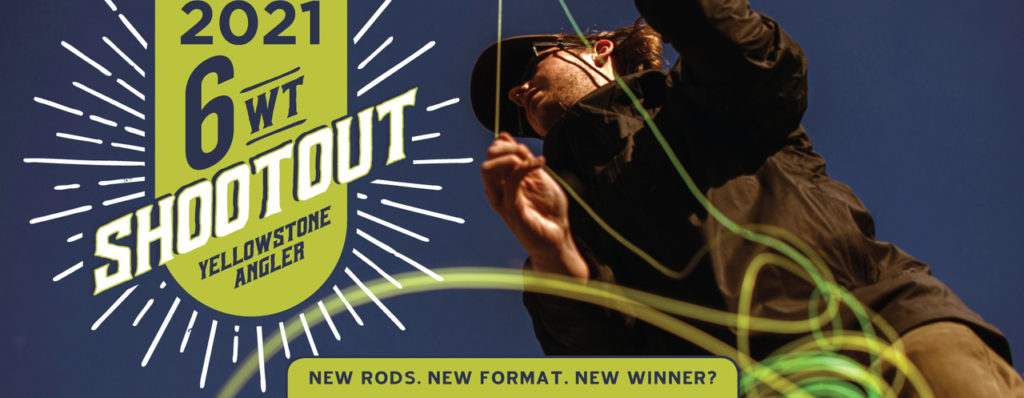
Our last 6-weight Shootout was back in 2016, and since then many manufacturers have introduced some great new rods, utilizing new materials, new tapers, and in some instances, new components.
We wanted to take a look at and cast all the best 6-weight rods we could get from a variety of the top manufacturers. We ended up with a total of 41 rods to cast. Several of these were the same basic 9 foot six weights, but with a fighting butt. Rather than have this many rods in the total write up, we decided to hone in on the ten best 6-weight rods, along with what we felt was the best mid-priced rod, and the best inexpensive rod. To determine the top ten, we selected the rods that performed best at a combination of 30, 50 and 75 feet.
It just so happened that the Hardy Shadow, our best mid-priced rod, at $389.95, finished inside the top ten, so we added our best inexpensive rod – the Echo Carbon XL, at $169.00.
In our objective charts that give overall weight, swing weight and country of origin, you’ll see a chart for the Best in Test, giving the top 11 rods, and the other we called the Best of the Rest, which shows all the rods we cast.
In order to refine our conclusions, we decided not to publish all our notes and scores on these other 30 rods, but if you want more info on these rods, just call us or e-mail us and we’ll be happy to provide this information.
If you’d like to read more about the other 30 rods tested, we have prepared a PDF describing each rod’s action, performance and components. To gain access to this PDF you can call us, e-mail us, or click on the window below and we will e-mail you a copy of it.
A lot of anglers love to use a 5-weight as their all-around rod, but a 6-weight can make more sense in a lot of circumstances. 6-weight rods have more guts to make fishing larger dry flies like hoppers a breeze, yet the best 6-weights will still have the delicacy to fish small dries on light tippets like 5X and 6X. They are also better rods for fishing a variety of nymph rigs, especially when you are using multiple flies, some weight like split-shot, and indicators. If you want to chuck some medium-sized steamers with a sink tip, a 6-weight rod makes this easy.
The 6-weight rods also have the power to pick up lots of line to make an immediate re-cast, as you often do while fishing out of a drift boat, (should your first cast be off target). Fishing big, wind resistant rigs like a “Chub/Rub” combo, (a size #8 Chubby Chernobyl dry with a size #8 rubber legs nymph behind it), is far easier with a 6-weight rod. For nymph fishing, 6-weights work better for chucking a two-nymph combo, like a #8 weighted rubber legs, with a smaller tungsten bead head dropper. Once you add a big, wind resistant strike indicator and some split shot, throwing the whole rig is far easier with a 6-weight rod than with a 4-weight or 5-weight.
A good 6-weight rod has the power to play bigger fish when you are trying to pull them away from undercut banks or underwater logs or boulders using 2X – 4X tippet. And to help with playing fish, you’ll find that many of these rods we tested come in models with a short fighting butt. A good 6-weight should also be able to cast 75-80 feet with a small damsel nymph or mini leech, and have the guts to keep that big angry lake brown out of the weeds.
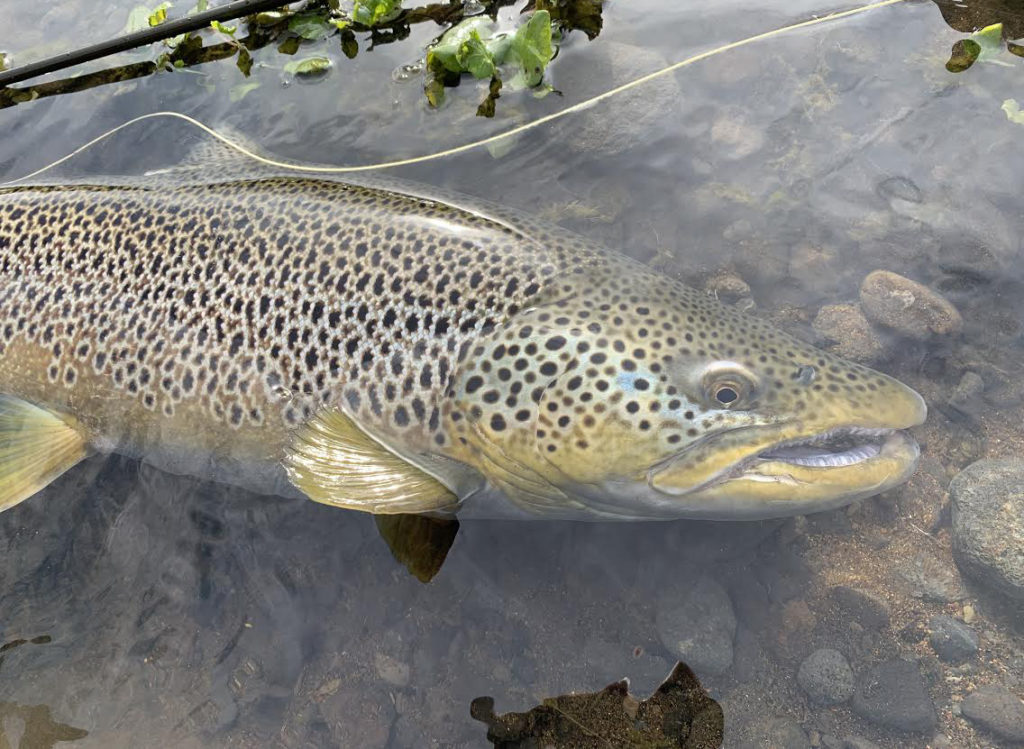
On a windy day, choosing a 6-weight rod over something lighter makes a lot of sense. With the more powerful 6-weight rods you can really punch your cast into a strong headwind of 15-20 mph. Some of the lighter action 6-weights however, don’t have this capability.
Fishing streamers is a joy, as these rods have the power to drive a 10-15 foot sinking tip line with good sized streamers, right up to size 2, with ease. They won’t throw a heavy articulated fly quite like a 7 or 8-weight, but surprisingly there’s a lot you can do with the best 6-weigths. And they will wear you out less than streamer fishing all day long with a heavier rod.
The best 6-weights must be delicate enough to fish smaller dry flies very effectively on light tippets, right down to 5X and 6X. They must be accurate, especially at the short to medium distances and be able to make delicate presentations when called for. They are ideal for fishing bigger, more wind resistant dry flies like hoppers or stoneflies. But if you unexpectedly run into a surprise PMD or Baetis hatch, you don’t want to go back to the car for a 4 or 5-weight rod. A great 6-weight can do it all.
For all these reasons, 6-weight rods have proven to be the most popular size with anglers traveling to New Zealand and Argentina to fish for trout. With today’s lighter yet stronger graphite materials and new resins, they are also becoming the go-to standard for fishing southwestern Montana’s freestone rivers such as the Big Hole, Madison, and Yellowstone.
Scott introduced its terrific new Centric this year, which replaced their top rated Radian. Douglas, whose Sky won our last 6-weight Shootout, made some dramatic moves with graphene and a re-design to come up with their new Sky G. Hardy also gives us a new and improved top of the line rod, called the Ultralite, which has impressive power and replaced the Zephrus. New Sintrix technology turned Hardy’s Shadow into a terrific mid-priced rod. The G. Loomis NRX+ rods are one of the best 6-weights, giving their superb Asquith a run for its money. Sage gives us their new Sonic, which performed as well as the Sage X, at nearly half the cost. And finally, there is our best inexpensive 6-weight rod – the Echo Carbon XL, which beat the new Fenwick Aetos. Unfortunately, we were not able to test the new Winston Air 2 6-weight, since at the time of the test it was still in the final design process. This was too bad, since we were highly impressed with the Air 2 9’#5.
Most of you are familiar with our previous Shootouts, and our rating methodology. We realize, however, that you are reading this primarily to see how the various rods we tested fared. Accordingly, we have revised our format and we are presenting the results first. If however, you are unfamiliar with our Shootouts and wish to understand our testing and scoring methods, go directly to the Methodology and Scoring section please click here: “Methodology and Scoring”
1. Douglas comes up with another winner in its light and powerful Douglas Sky G. Nothing could match its presentation from 30-50 feet, which is the distance we are most often fishing with a 6-weight rod.
2. The G. Loomis Asquith placed second, with a terrific all-around action that is a happy medium between the incredible feel of the Sky G and amazing power of NRX+.
3. The G. Loomis NRX+ was impressive, especially at longer distances. We gave it a perfect score for indicator nymphing, and at $795, it’s three hundred dollars less than the Asquith.
4. The good-looking Hardy Shadow put in a superb performance, and at $389.95, is our pick for the best mid-priced rod.
5. Echo’s excellent Carbon XL at $169.00 put in a solid performance, to beat the re-designed Fenwick Aetos, as our pick for the best inexpensive 6-weight rod.
Overall winner – Douglas Sky G
Best powerful 6-weight – G. Loomis NRX+
Best saltwater 6-weights – Douglas Sky G Salt, Hardy Zane Pro
Best mid-priced freshwater 6-weight – Hardy Shadow ($389.95)
Best mid-priced saltwater 6-weight – Orvis Recon Saltwater ($549)
Best streamer/sink tip 6-weight – G. Loomis NRX+
Best mid-priced streamer/sink tip 6-weight – Orvis Recon (Freshwater)
Best inexpensive streamer/sink tip 6-weight – Orvis Clearwater
Best inexpensive freshwater 6-weight – Echo Carbon XL ($169)
Best inexpensive saltwater 6-weight – Echo Boost Blue ($249.00)
Best Price – Echo Carbon XL ($169)
Best craftsmanship – G. Loomis Asquith, T&T Avantt
Best warranty policies – Douglas Sky G, G. Loomis NRX+, Echo Carbon XL
Most fun to fish – Douglas Sky G, G. Loomis Asquith
Lightest overall weight – Sage Trout LL
Lightest overall swing weight – Douglas Sky G Salt, Moonshine Vesper
Best indicator/nymphing rod – G. Loomis NRX+, Beulah G2 Platinum
Best 30’ performance – Douglas Sky G
Best 50’ performance – Douglas Sky G
Best 75’ performance – G. Loomis Asquith, G. Loomis NRX+
Softest/most buttery feel – Echo Bad Ass Glass
Best single hand spey – Beulah G2 Platinum
Best high stick/mending capabilities – Beulah G2 Platinum
Eye catchers – G. Loomis Asquith, Scott Centric, Hardy Ultralite, T&T Avantt
Best chance to clear a tangle (biggest guides and tiptop) – Douglas Sky G Salt, Hardy Zane Pro, Echo Boost Blue, Echo Bad Ass Glass
Thickest grip for big hands – Taylor Anomaly, Beulah G2 Platinum, TFO Axiom II-X
Most likely to make your fishing buddies jealous – G. Loomis Asquith
Most likely to hook a hog – All of them!
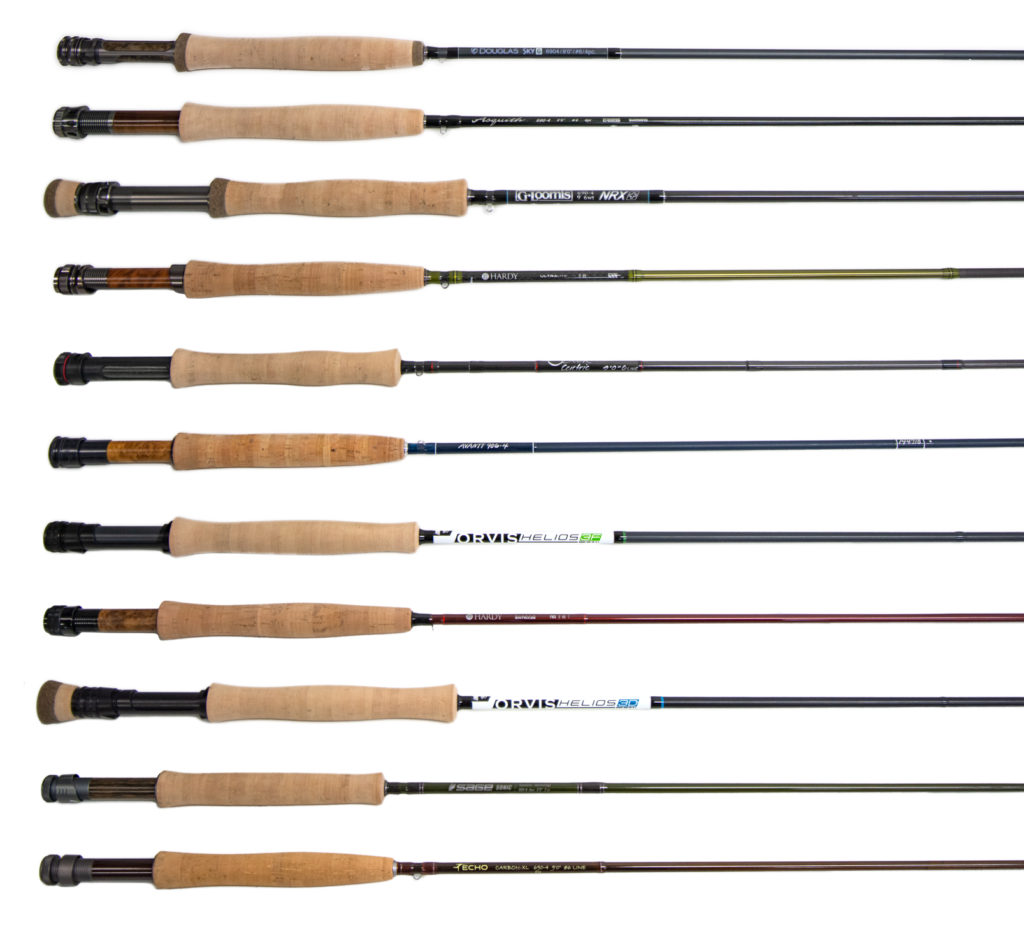
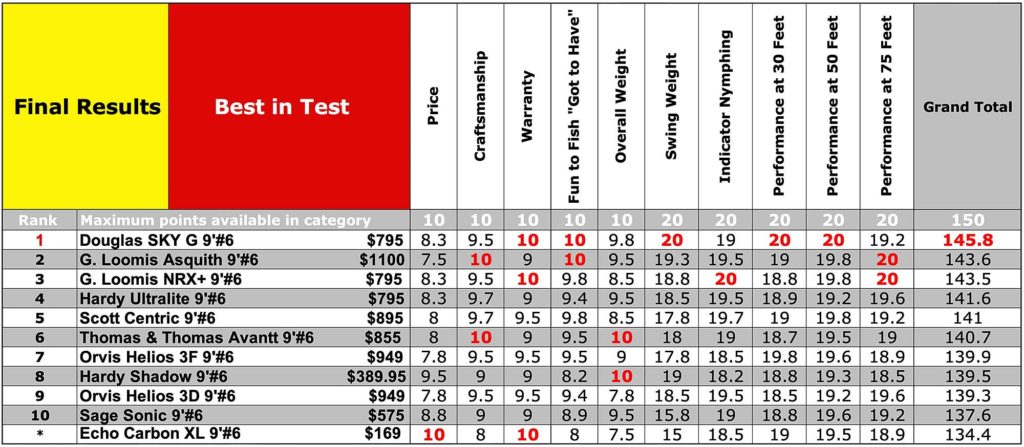
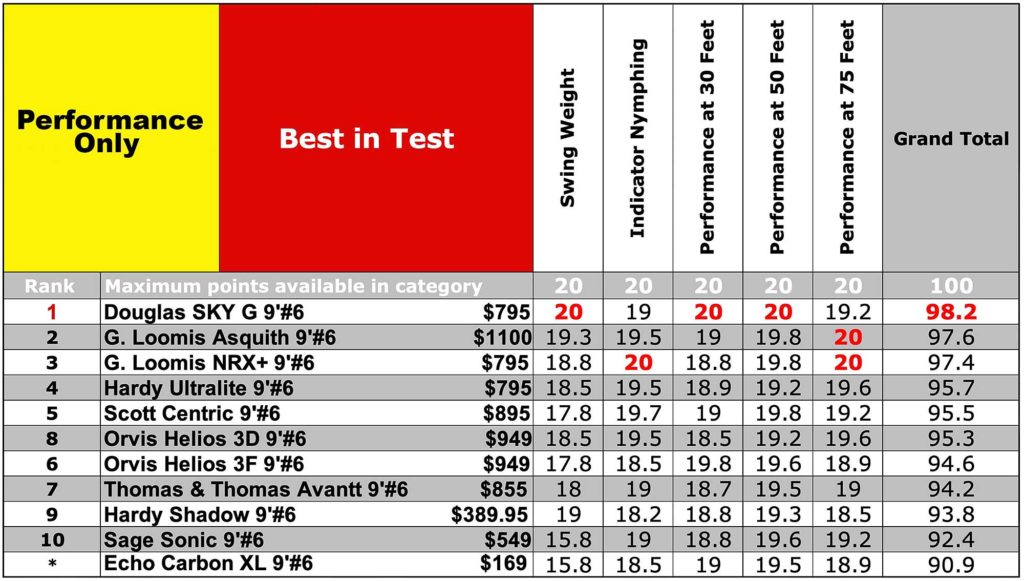
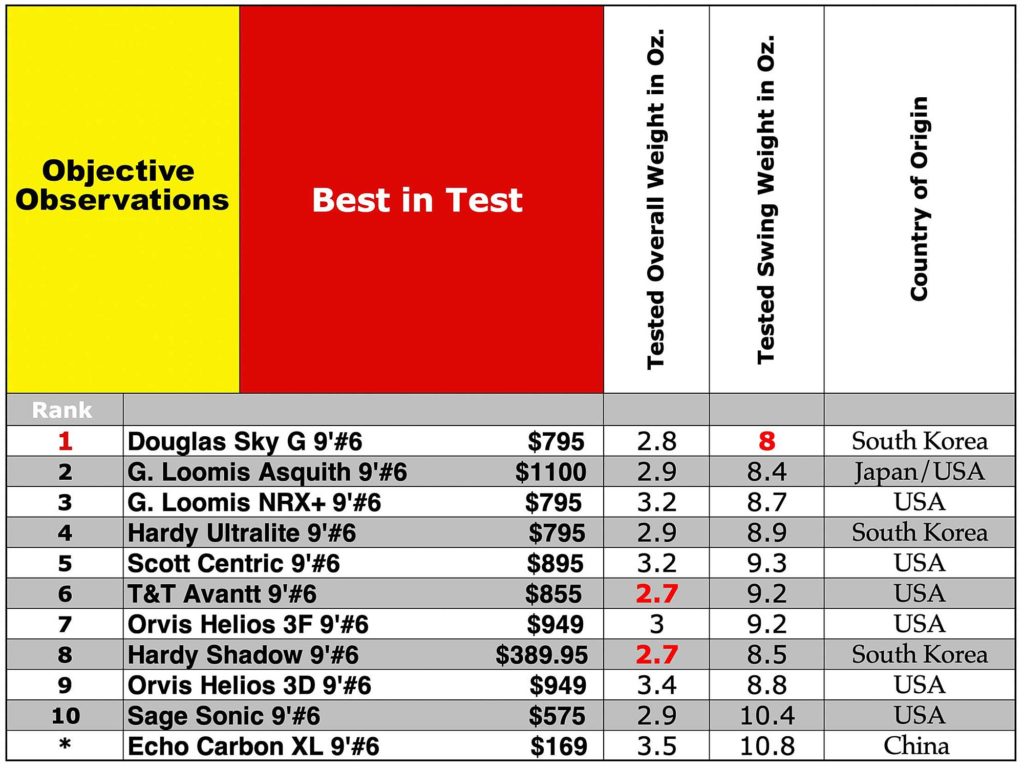
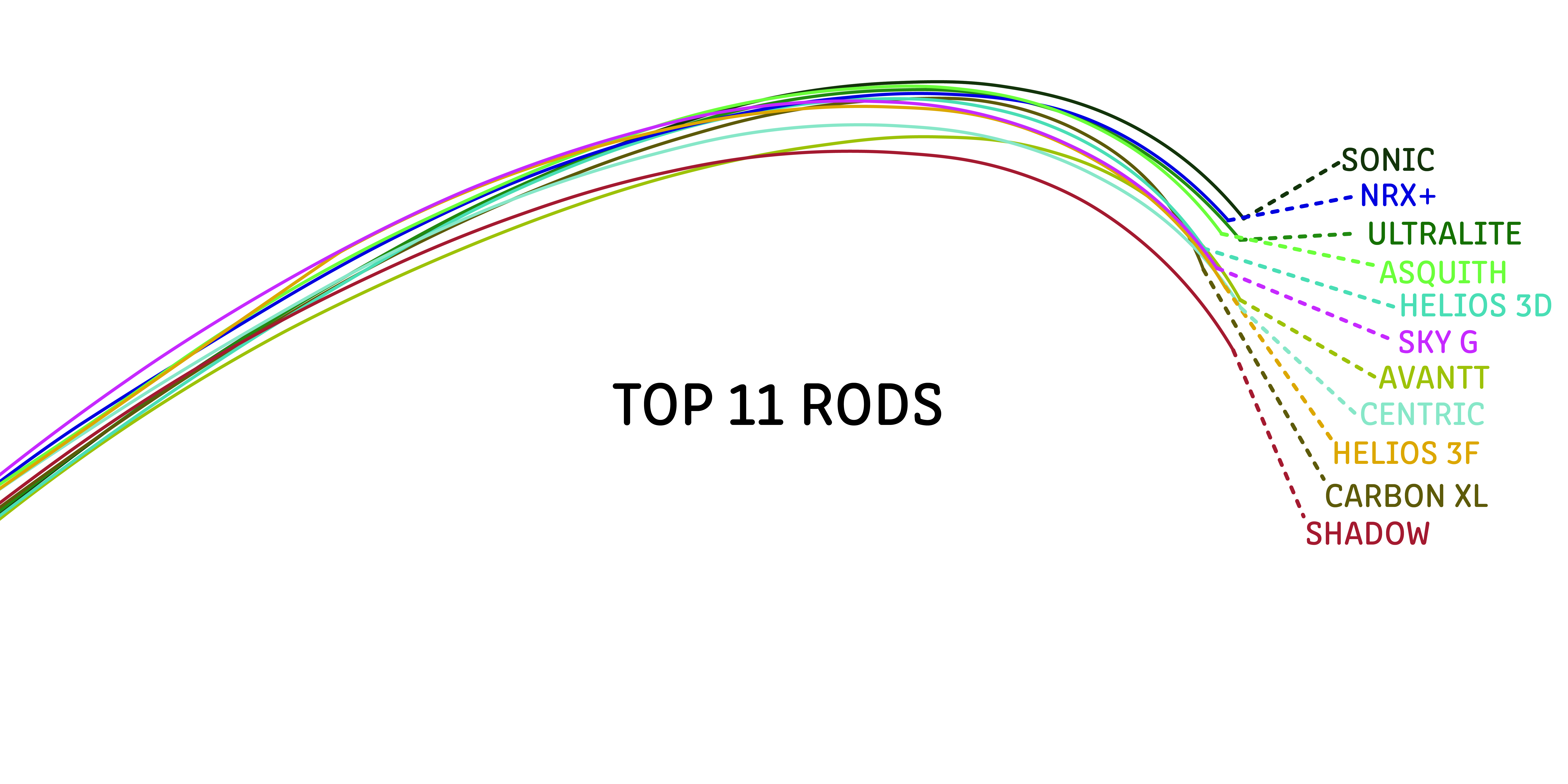
George’s observations on the deflection charts
Today the deflections of our top 11 rods are much more similar than they were ten years ago. Manufacturers have learned that to cast well at all distances, fly rods need to have strong butt and mid-sections, but with softer, more flexible tips in order to get good performance at both close and long range. All the best rods we tested have medium fast, to fast action profiles.
Of all the top 11 rods, you can see that the Sky G has the stiffest butt section, but then one of the softer tips (the tip bends more). Look at the Sonic, NRX+, Asquith and Ultralite – they have very similar deflections and are more powerful than the other Rods. This is why they all perform so well at mid to long distances.
Further down in the shootout you’ll see more complex deflection charts, including close ups. Click here to jump to the rest of the charts
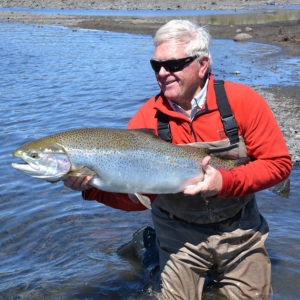
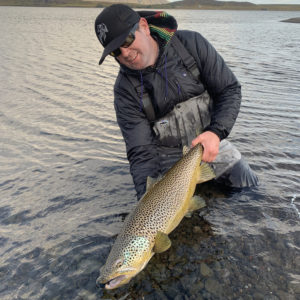
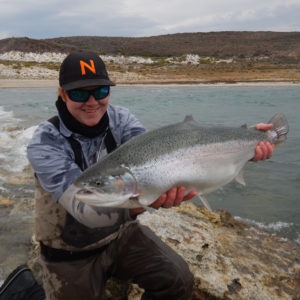
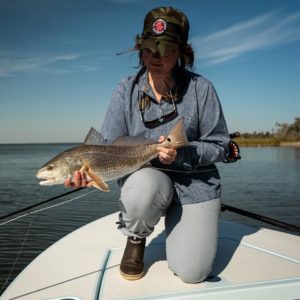
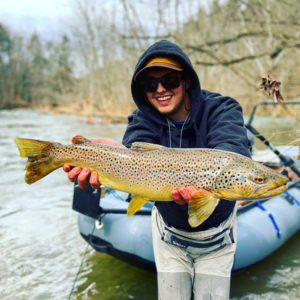
I’ve been in the fly-fishing business now for over fifty years, as a guide, fly shop manager and finally owner. I’ve developed a reputation as a good angler in both fresh and saltwater and many leading rod makers and manufacturers consult with me in their rod design process. Over the years I’ve worked with G. Loomis, Sage, Scott, Winston, Tom Morgan Rodsmiths, and Douglas in the design and testing of their rods.
My son Jamie is also a dedicated fly fisherman and has developed into a great caster and a person who I can trust in judging a rod’s performance. He has been a very important and integral part of our Shootouts and tackle comparisons over the years. He and Chloe Nostrant are also responsible for many of the great photographs you’ll find in our Shootouts.
Logan Brown, our guide bookings manager has lived in Montana for over fifteen years now and has become one of the better anglers in our area. Of all the guys at the shop, he spends the most time on the Yellowstone and has the brown trout photos to prove it. He has fished for Golden Dorado as well as for big Rainbows at Jurassic lake. He has proven himself time and time again to be a good angler and caster, even in the toughest conditions imaginable
Chloe Nostrant has been working at the Yellowstone Angler now for over 6 years. She has been instrumental in putting our Shootouts together, including the photos, videos, creation of the deflection charts, and all the “behind the scenes” digital formatting that goes into them. She guides anglers in YNP and has set up several women’s fly-fishing classes, available through the shop. Having a woman’s perspective as a good angler and caster has proven to be a big asset for us.
Holden Russell has worked for the Yellowstone Angler for the past three years. This summer he will be guiding full time as a core guide for the Yellowstone Angler. As one of the best younger, upcoming guides in Montana he is very passionate and knowledgeable about fly-fishing and has put a lot of time on the water. His comments and thoughts on different rods felt spot on.
I think you will find everyone’s comments interesting and worth reading. Not everyone agrees, and that’s OK. As you’ll see, however, we were all pretty much in agreement on which were the best rods. You can read each person’s opinions and notes by simply clicking on their comments below each of my individual rod write ups.
We are giving you OUR opinions in these Shootouts. This is a subjective test designed to help give you a guide to which rods you want to try or buy. But we know from our readers’ comments that the vast majority of anglers are in general agreement with our findings.
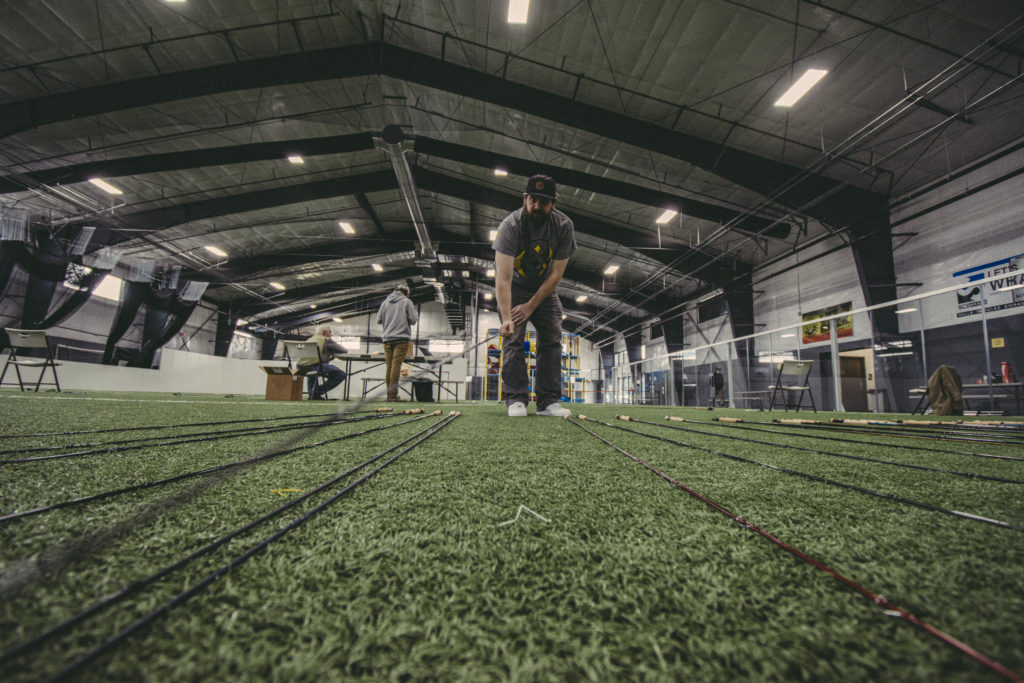
#1 Douglas Outdoors SKY G 9’ #6 $795.00

*Note: The Sky G Salt could have been included in our top ten, however it is essentially the same rod as the Sky G except for its larger cork with a fighting butt and saltwater guides. It performed virtually identically to the Sky G, so if you want the number one 6-weight in a saltwater version – this is it.
In our 2016 6-weight Shootout, the new Douglas Sky was a surprise winner over a lot of great rods. Then in our 2020 5-Weight Shootout, the re-designed Douglas SKY G was the winner in our presentation rod category. Now Douglas gives us another amazing 6-weight that edges all the other 6-weights we tested! The thing that impressed me the most with this new G model when we first saw it as a 5-weight was its extremely light swing weight. The same is true with the new SKY G 6-weight. Not only is this rod noticeably lighter in your hand than other top 6-weights, but there is just nothing that can come close to matching it casting at short to medium distances, where I’m fishing 90 percent of the time.
Fred Contaoi, Douglas’ head rod designer has done a lot of work in designing and fine-tuning these new G series rods, and our testing confirms the wisdom of his choices. (Editor’s note: George’s enthusiasm for this rod is no doubt informed in part, by the fact that his advice and input was solicited by its designer when the prototype Sky G’s were developed and tested. Nevertheless, the Sky G’s performance was an equal sensation with all of our testers, who had no input in the rod’s design).
The final version of this 9-foot SKY G is just a fantastic rod, that produced an amazing performance in our Shootout at both 30 feet and 50 feet, picking up perfect scores from me at both distances. The SKY G gave me a wonderful sense of feel especially at the shorter distances. I loved the way I could cast off the tip of the rod in close. Only at long range was it lacking in power compared to the stronger 6-weights, like the G.Loomis Asquith and NRX+.
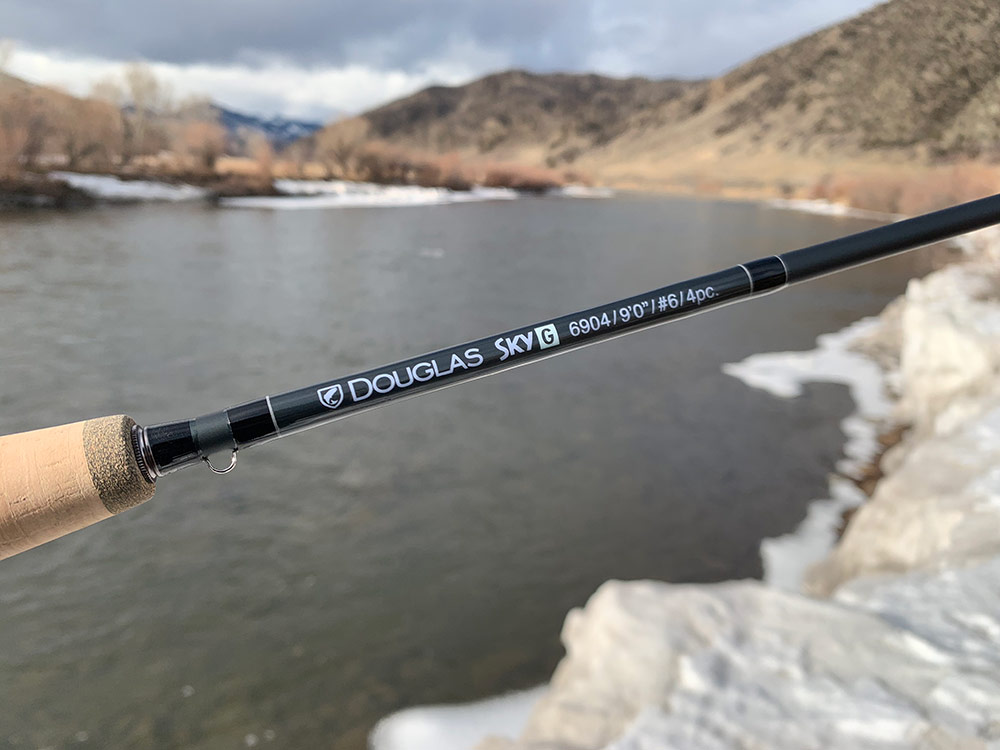
Like the 5-weight SKY G, the 6-weight has good butt and mid-section power but with a slightly softer tip. The big question I had is how Fred can get this rod so light in swing weight compared to the other rods. The answer is the use of Graphene. These new SKY G rods are composed using G-Tec platelets. As explained by Fred, platelets are like building blocks that are microscopic in size. The platelets make up a small part of the resin matrix while offering substantial benefits in using less material and maintaining high integrity in both linear and hoop strength, with added impact resistance.
Fred uses a “secret” resin with new extremely lightweight graphite and what he calls a “G Armor” coating. He doesn’t want to give up his secrets to success and I guess I can’t blame him.
This new SKY G dampens quickly, making it wonderfully smooth to cast. But the amazing thing is how light it is in your hand considering how much power it has. If you look at our Objective Observations chart, the swing weight for the SKY G was only 8.0 oz., far less than even the extremely light Asquith at 8.4 oz., and the NRX+ at 8.7 oz. The Orvis Helios 3F, another light rod, is at 9.2 and the Scott Centric is at 9.3 oz.
The Sky G is an attractive rod, finished in a non-glare gray with black wraps, trimmed with light gray on the butt. The epoxy coatings were all excellent. Douglas uses three coats of epoxy on the wraps rather than one thicker coat like so many other manufacturers do. Alignment dots on each section are handy and each section is marked #6 so that you won’t mix them up with another Sky G like a #5 you might have.
I especially like the Sky G’s guide set, starting with one of the new CERECOIL stripping guides that use a titanium frame with a super slick Zirconia ring insert that is designed to never come out of the frame, even as the frame flexes. Top of the line REC nickel-titanium, flexible one foot guides are used the rest of the way. These are very light but have proven to be extremely reliable. You’ll find a hook keeper just above the cork handle. A cigar-style handle is used with a swell slightly farther up the handle than most. A stack of narrow, very high-quality cork rings are used. Contrasting rubber/cork rings are used both at the top and bottom of the grip that provide increased durability. A gray anodized double up-locking skeleton seat is used with an attractive burled blackwood insert. Nylon washers on the upper side of the rings help provide a very secure lock up.
The perfect line: Scientific Anglers Amplitude MPX in WF-6-F
George’s casting notes
Performance at 30 feet 20.0 out of 20
Extremely light in hand, and super accurate. I can cast very easily off the tip with just a flick of the wrist. Nothing matched the Sky G at short range
Performance at 50 feet 20.0 out of 20
I’m getting beautiful tight loops and terrific accuracy with very little effort. Nice delicate presentations were easy. Better feel (and lighter) than all the other 6-weight rods at mid-range.
Performance at 75 feet 19.2 out of 20
Still tracks well, with nice loop control, but lacking power compared to the Asquith and NRX.
#2. G. Loomis Asquith 9’ #6 $1100.00

Since its introduction, the Asquith has been one of my favorite rods in sizes from #5, all the way up to the 9 foot #11 that I use for big tarpon. Until Douglas produced their new SKY G, the Asquith would have been the lightest 6-weight rod, even lighter than the new Loomis NRX+. There are few rods that can match the power you’ll find on tap with the Asquith. At long distance I gave it a perfect score, matching the NRX+. Here is one rod that really combines impressive power with smooth, tight loops. I was blown away by such a light rod in swing weight, that has this kind of explosive power. At long distance, this rod fires effortlessly with smooth, tight loops that really cut into the wind. At short distance, the softer tip gave me good feel and accuracy. Only the Sky G and Orvis Helios 3F were better short.
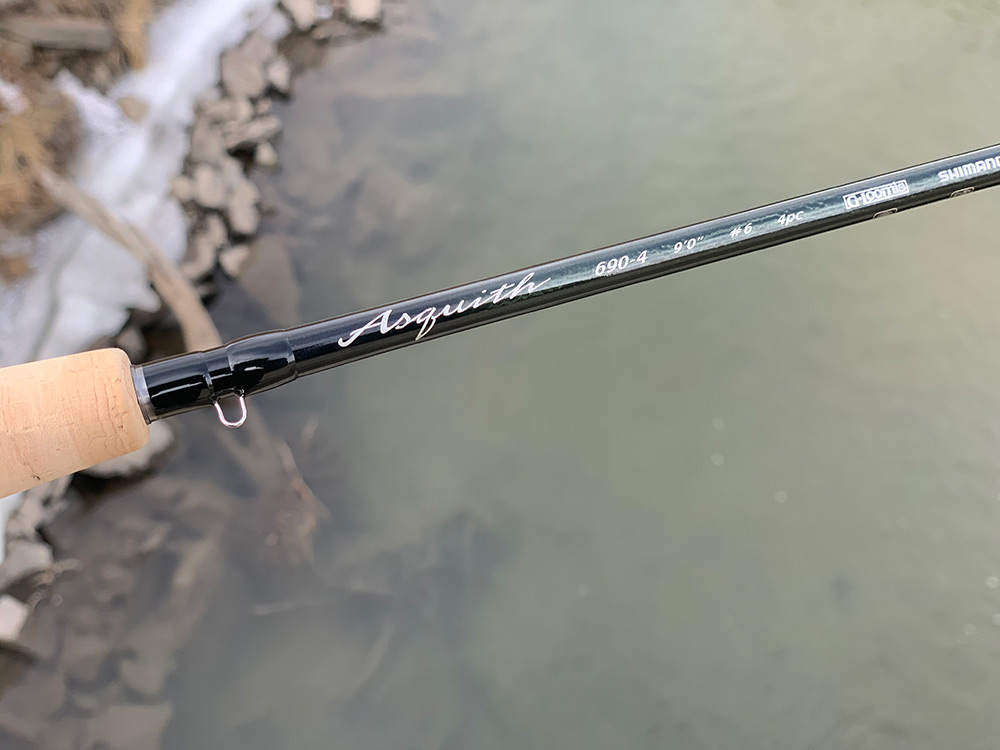
Steve Rajeff at G. Loomis helped design the tapers and mandrels for the Asquith rods. The blanks are manufactured at the Shimano factory in Japan using their new Spiral-X technology. The finished blanks are then shipped to the G. Loomis factory in Woodland Washington, where the rods are completed.
As G. Loomis tells it, Spiral-X technology is a complex three-step process. Shimano developed a special graphite tape, called infinity tape, which is wrapped on the mandrel on a 45-degree axis. Next, a layer of “muscle carbon” is wrapped on in a conventional manner. The final step is another wrap of the infinity tape, but at an opposing 90-degree angle to the first, so that the infinity tape forms an “X” pattern.
The beauty of this process is that it uses 15-20% less graphite to get the exact same strength as the older NRX rods, which we know from experience are stronger than any other rods we’ve used.
The other benefits of Spiral-X are that it reduces any twist in the blanks, and more importantly, reduces ovalization as the rod bends. This gives an angler more feel combined with an enormous amount of reserve power. Only the new NRX+ rods track as well as the Asquith.
The Asquith is a fast action rod with very good butt and mid-section power, but with a softer tip that helps provide great feel and excellent accuracy at all distances. If you look at our deflection charts, you’ll see that the Asquith and the NRX+ are two of the stiffer rods in our Shootout, along with the new Hardy Ultralite.
The Asquith is one of the lightest rods in this Shootout. Only the Sky G is lighter in all important swing weight. This light weight in hand makes it a delightful rod to fish all day, especially if you are doing a lot of false casting fishing dry flies.
Really, the only real drawbacks are the price –at $1100 it is the most expensive rod in our Shootout, $150 more than the Orvis Helios rods, and $300 more than the Sky G, and the replacement cost if you break it. But just this year Loomis is offering to replace the tip section for only $75.00. Asquith rods are extremely tough, due to their construction, and we very rarely see one broken. I’ve never broken my #11 Asquith on big tarpon, but have landed dozens of 50-160lb. fish on that rod.
The Asquith is a gorgeous rod, with extremely good craftsmanship. In the sunlight, the dark green finish just sparkles! Complementary dark green wraps are used, and coated perfectly with multiple coats of epoxy. The cork handle is a comfortable half wells shape, with the swell a little forward of the middle of the grip. A stack of thin, high quality cork rings are used much like on the NRX+. The gray single uplocking skeleton seat uses a gorgeous bamboo insert, coming from the same factory that makes high-end Lexus steering wheels. The ring on the single uplocking seat was very easy to grip and locks up extremely well.
Guides start out with a hook keeper ahead of the cork handle, followed with one of the new titanium frame guides that has a very thin SIC ring. The rest of the guides are the top-notch Recoil nickel/titanium snake guides that will flex but never break.
The perfect lines: SA Amplitude MPX (best all around), or the SA Anadro/Nymph (nymph and streamer fishing), both in WF-6-F.
George’s casting notes
Performance at 30 feet 19.0 out of 20
Good feel and decent accuracy but the Sky G was a lot better in close. Nice and light in my hand.
Performance at 50 feet 19.8 out of 20
Throws incredibly tight loops with ease, giving me terrific accuracy. This is a wonderfully light rod in swing weight with a lot of power.
Performance at 75 feet 20 out of 20
Tied with the NRX+ as the best long-range rod. Tracks beautifully and maintains wonderful loop control and accuracy. Terrific power on tap, when you need it.
#3. G. Loomis NRX+ 9’ #6 $ 795.00

The NRX+ is an impressive improvement from the older NRX rods. Steve Rajeff, G.Loomis’ head rod designer and 14 time all-around world fly casting champion, has done a terrific job in the re-design of the original NRX rods. The NRX rods were always one of my favorite rods, but these new NRX+ rods are even better. They are lighter, stronger, and dampen better than anything that G.Loomis has given us in the past, including the Asquith. When you cast an NRX+, you’ll immediately notice how smooth they are and how well dampened they are compared to other rods.
In upgrading the NRX rods, Steve utilized a blend of three things: Mega Modulus+ Graphite, GL8 Resin, and Multi-Taper Design. As Steve explained, the new Mega Modulus+ graphite fiber is slightly higher in modulus but has a much higher strain rating. This makes the blank much stronger under a “lifting load” with less overall material used. G. Loomis has built some of the toughest rods we’ve ever fished and it takes a lot to break one. Knowing the new NRX+ is even tougher than the old NRX is great news!
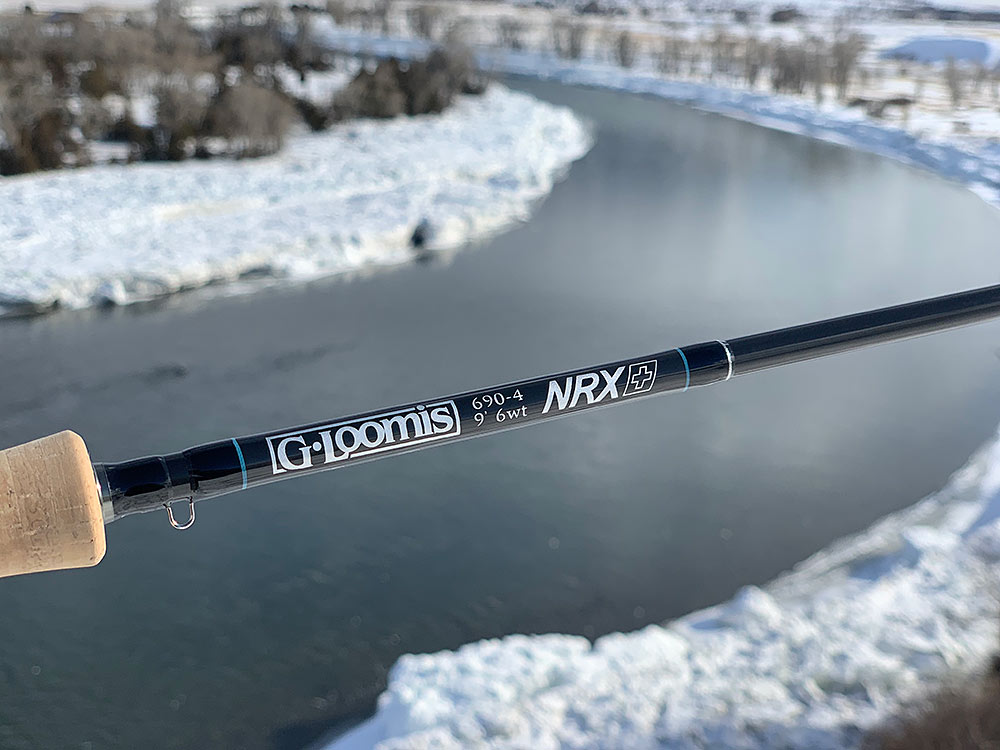
GL8 resin is “self-propagating”, meaning the resin creates its own Nano-particles. These particles are distributed evenly and uniformly, unlike older resins where the particles were mixed in. Since the GL8 resin is more uniform, it penetrates the graphite fibers more effectively, thus requiring less resin. This new resin system, along with a new scrim, results in a lighter but more durable blank.
In looking back at the old NRX specs, these new NRX+ rods are slightly lighter in overall weight but substantially lighter in swing weight.
A cornerstone of their new technology is using a multi-taper design, a process that removes material from areas where a rod is least likely to break, and adds material to prevent breakage where it’s more likely to do so. When used in the top half of the rod, this creates a thin diameter tip section with excellent swing weight, but more importantly helps the rod to recover and dampen quickly.
In casting this new NRX+ rod, the improvement in recovery and dampening was dramatic! There are no other rods in our Shootout that are as smooth, dampen as quickly, or track as well as the new NRX+ rods.
The NRX+ rods are an attractive dark steel gray color, with midnight blue wraps, that almost look black, and trimmed with lighter blue and silver on the butt section. The cork handle is now a full wells, using a stack of very high quality cork rings with one rubber/cork ring at the base of the grip.
A dark gray anodized solid aluminum, double uplocking seat is used, without any wood spacer. On this 6-weight NRX+ Loomis uses a small ¾ inch fighting butt with a rubber cork cap. I found the reel seat to lock up well but the rings are a little harder to grip than some.
The guide set up starts with a hook keeper just above the grip, then a single stripping guide, using a titanium frame and a thin wall SIC ring is used that is slightly smaller than the one used on the Asquith. The rest of the guides are the excellent nickel/titanium one-foot guides that will bend but never break.
The perfect lines: SA Amplitude MPX (best all around) or the SA Anadro/Nymph (nymph and streamer fishing), both in WF-6-F
George’s casting notes
Performance at 30 feet 18.8 out of 20
Tracks perfectly but accuracy and feel not nearly as good as the Helios 3F or Centric. The Sky G was in a class by itself here.
Performance at 50 feet 19.8 out of 20
With more line out the rod loads better and now I’m getting nice tight loops and great accuracy. At mid range I felt it was slightly better than the Helios 3F, but couldn’t match the SKY G
Performance at 75 feet 20 out of 20
At long range this rod is a cannon! Fantastic tight loops and superb accuracy. Here it equals the perfect score of the Asquith. A little heavier in hand than the 3F though.
#4. Hardy Ultralite 9’ #6 $ 795.00

The Ultralite is Hardy’s brand new, top of the line rod that replaces the Zephrus. I like everything Hardy has done with this rod and was impressed with it when Howard Croston, Hardy’s head rod designer, brought it by our shop last fall so that we could to try it out. Howard is a fantastic caster and has proven himself a great angler too, in heading up England’s winning team in the most recent World Fly Fishing championship.
I like everything about this rod, from the way it looks, the components used, and of course by the way it casts as a 6-weight. It is light in overall weight and also in swing weight, falling in just behind our top three rods. The thing that surprised me the most is that this is a relatively stiff rod with more power than most of the other 6-weights. Check this out on our deflection chart, and you’ll see that the Ultralite has about as much power in the mid-section as the Asquith and NRX+.
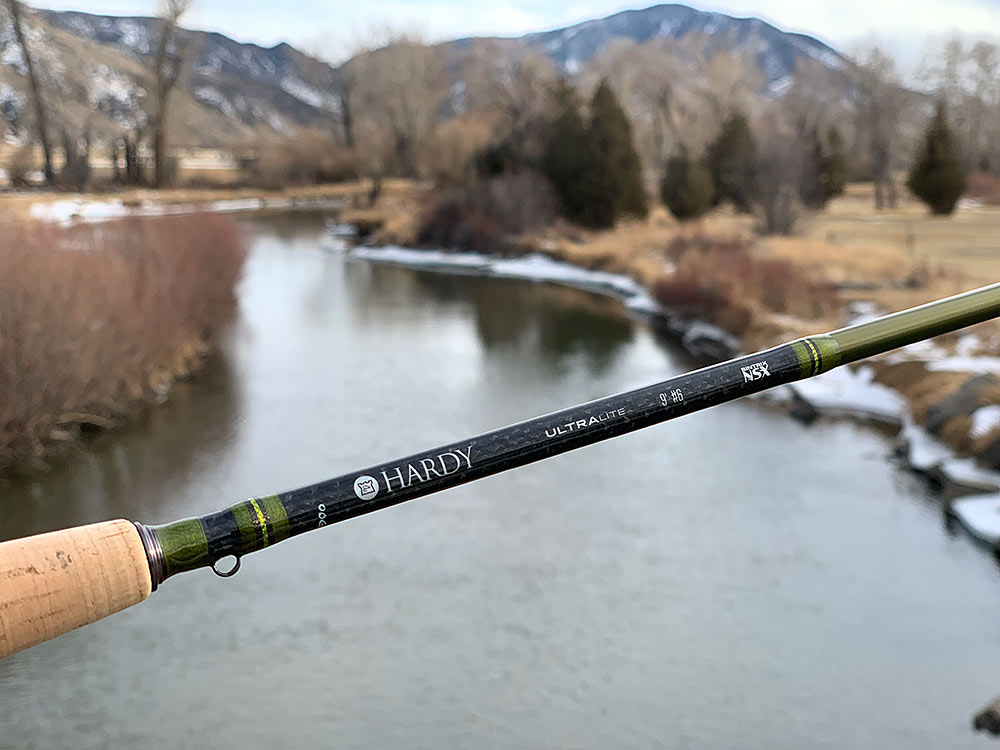
All this power makes the Ultralite a great all around 6-weight for fishing larger dry flies, but also one that makes a great nymph fishing rod that is capable of throwing all kinds of heavy rigs. We rated it one of the best in our Indicator Nymphing category, just behind the NRX+ and Centric. It is also one of the best 6-weights going if you like fishing larger dries like hoppers and chubbies, with a nymph dropper.
Howard Croston totally re-designed this rod using the latest Sintrix NSX material and new proprietary resins that allow Hardy to build a lighter and stronger rod than before. These new materials allowed Howard to give us a rod that is both lighter and more responsive, and allows the angler to feel the line load better during the casting stroke, providing better accuracy. The Ultralite is a relatively fast action rod.
This is a great looking rod, with the blank finished in an attractive golden olive color with medium olive wraps. On the butt section, just above the handle is a gray crosshatched section with the Hardy insignia. Some interesting wraps are used with olive, black and gold in the middle on the butt section. Hardy uses a half – wells, cigar shaped handle with standard sized, extremely high quality cork rings, as we have come to expect from Hardy.
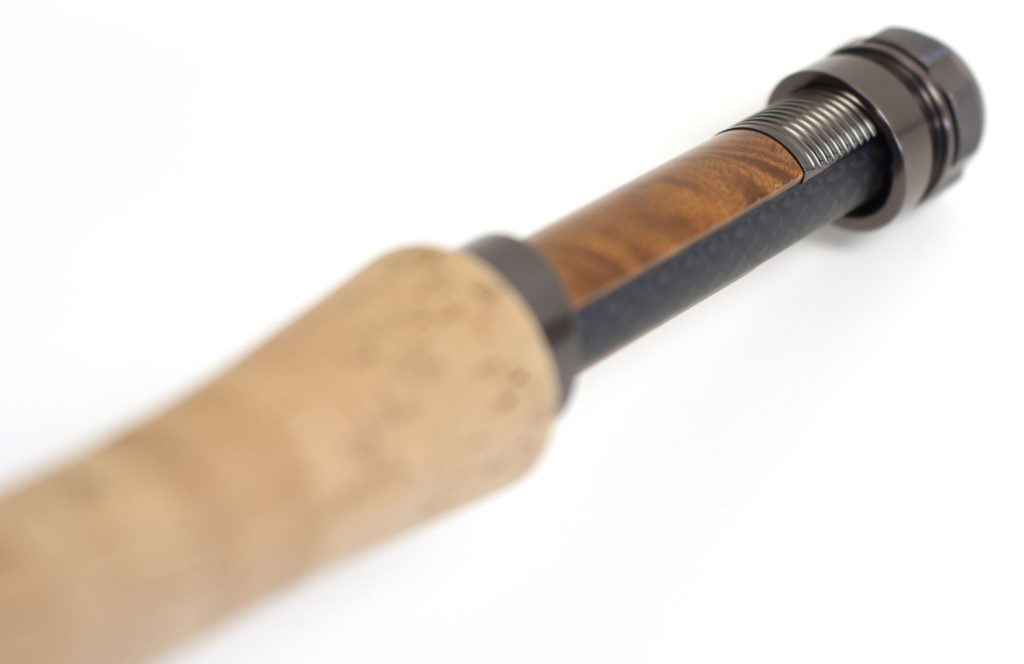
The reel seat is just gorgeous and very unusual. It uses a dark gray anodized single uplocking skeleton seat with a nylon ring that gives a very secure lock up. The burled wood insert is combined with gray graphite insert. Very unusual, but great looking as well as functional. The upper hood on the reel seat is laser engraved with the line size.
For guides, Hardy uses one hook keeper above the handle and then one of the new CERECOIL stripping guides that use a titanium frame and a Zirconia ring insert. The rest of the guides are the best dark nickel/titanium single-foot guides that are flexible but will never break.
The perfect lines: SA Amplitude MPX (best all around) or the SA Anadro/Nymph (nymph and streamer fishing), both in WF-6-F
George’s casting notes
Performance at 30 feet 18.9 out of 20
The rod’s stiffness hurts the feel a bit in close and I’m not getting the kind of feel or accuracy that I had with the Sky G.
Performance at 50 feet 19.2 out of 20
I’m able to form nice loops with ease, and the rod tracks well. The accuracy was excellent but the rod feels a bit heavier in hand than the Sky G or Asquith.
Performance at 75 feet 19.6 out of 20
A powerhouse at long range, and tracks very well, but couldn’t match the accuracy of either the NRX+ or the Asquith.
#5. Scott Centric 9’ #6 $895.00

The Centric is Scott’s new rod that replaced the superb Radian. These cutting edge Centric rods are the most efficient rods that Jim Bartschi has ever created. They are designed to create high line speed, and flat stable loops that are easily generated at any distance. These new Centric rods combine new tapers and multi-modulus lay ups with a new resin system that increases fiber density and reduces weight. They feature Scott’s new generation ARC reinforcement that gives greater stability along multiple axes. New custom rolling equipment also allows Scott to control fiber placement and density with new levels of precision as the rod is rolled.
The bottom line is a new rod that performs even better than one of our old favorites, the Radian. The Centric’s ability to control loop shape and line speed at any distance gives anglers a wide range in versatility.
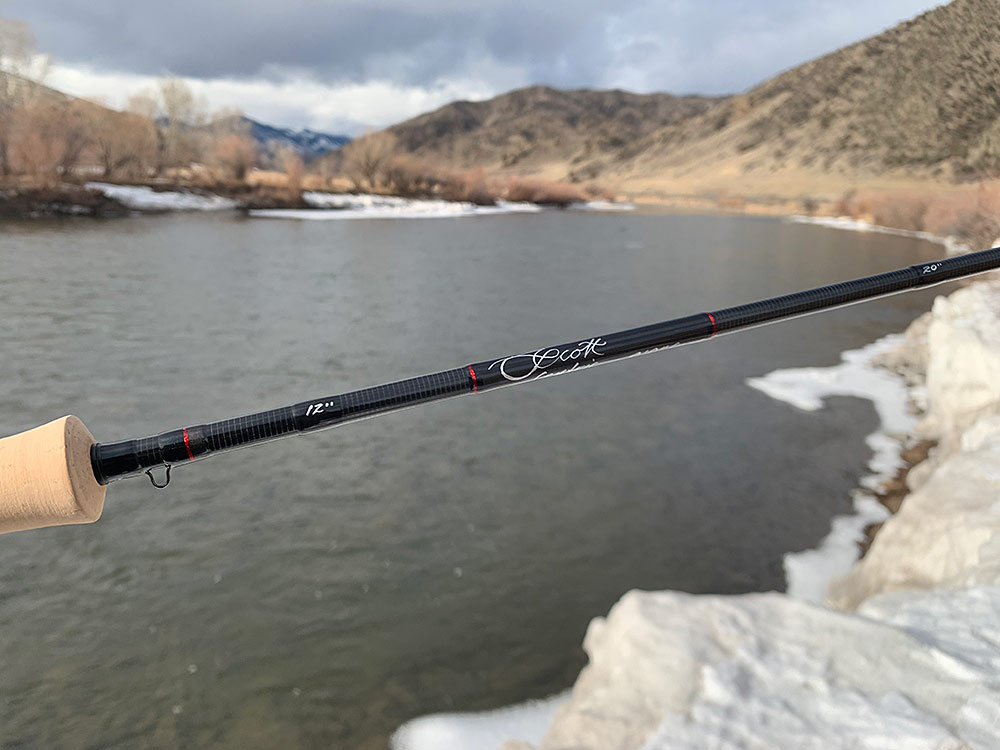
In looking at our deflection charts you can see that the Centric is slightly slower in action than the G.Loomis rods and the Sky G. It also has a softer mid-section than the Loomis rods, the Sky G and the Hardy Ultralite. I felt that the relatively stiffer tip on the Centric hurt its ability to load well in close at the shortest distances. At 30 feet it matched the Loomis rods, but the Sky G was markedly better.
For me, the middle distance of 50 feet was where the Centric felt the best. Now I was getting smooth, tight loops with excellent feel and accuracy. But at long range, the Centric couldn’t match the kind of power I was getting from both the G.Loomis Asquith and NRX+.
On the water, the Centic proved to be great for roll casting and mending – a lot more powerful than the previous Radian. For this reason it scored as one of the best rods in our Indicator Nymphing category.
I was surprised that both the overall weight and swing weight were slightly heavier than the older Radian, but it does have more usable power. In swing weight though, it was noticeably heavier than the Sky G, as well as the Loomis Asquith and NRX+.
The Centric is another attractive rod from Scott, and follows Scott’s tradition of using an un-sanded gray graphite blank that shows the tape wraps. The guide wraps are in black, trimmed with red on the butt section. The epoxy finish on the guides is especially well done. I especially like Scott’s measuring marks at 12 and 20 inches. I wish more manufacturers would do the same. The cork handle is another stack of thin, high quality cork rings. The Centric handle is a full wells shape, and like their previous Radian, the swell is quite a bit forward of the middle of the handle. This felt great to me, and you’ll grip this handle farther forward, which helps to reduce swing weight.
A single uplocking, black anodized seat is used with a self-indexing hood and a dark gray micarta insert. Even though only one locking ring is used, it is very easy to grip and tighten. A thin nylon washer is used between the ring and hood to secure a very positive lock up.
The guide set up starts out with a hook keeper, and then one titanium frame stripping guide with a SIC insert. The rest of the guides are dark colored hard chrome snake guides. We wished that Scott could have used the better nickel/titanium, flexible snake guides as found on the Asquith.
The perfect lines: SA Amplitude MPX (best all around) or the SA Anadro/Nymph (nymph and streamer fishing), both in WF-6-F
George’s casting notes
Performance at 30 feet 19.0 out of 20
The slightly stiffer tip hampered the amout of feel and accuracy. I couldn’t cast off the tip of the rod nearly as well as with the Sky G.
Performance at 50 feet 19.8 out of 20
This was the best distance for the Centric and I was forming perfect loops with very good accuracy. A wonderful rod for fishing medium distances.
Performance at 75 feet 19.2 out of 20
The rod tracked well and gave me nice tight loops but it just didn’t have the power I was looking for out long. The Asquith and NRX+ were far better at long range.
#6. Thomas and Thomas Avantt 9’ #6 $855.00

Although the Avantt is not a new rod, we felt it was a better 6-weight rod than their new Paradigm, which is much softer and slower in action. The Avantt is another classy rod from Thomas and Thomas with craftsmanship that is second to none.
Compared to the other top rods in this Shootout, the Avantt had a slower action and a stiffer tip. You’ll see this in our deflection charts. In overall power it performed best at mid-distances, lacking a little power at long range.
The Avantt uses T&T’s proprietary Strato Therm Resin, giving the rod incredible strength, low swing weight and lightning fast recovery.
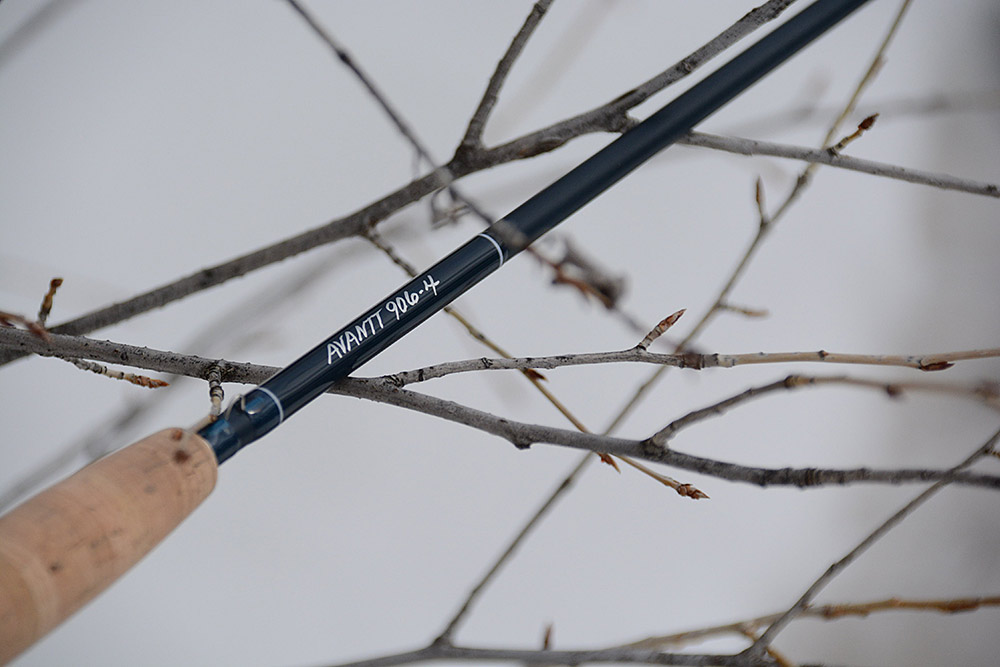
This is a handsome rod with the same superb craftsmanship that we have come to expect from T & T over the years. As in the past we gave the Avantt a perfect score for craftsmanship. Take one look at the thread wraps and their finish on the Avantt and you’ll see the ultimate in perfection. To obtain this kind of finish, multiple coatings are the key, and no manufacturer does this better than T&T.
The blank itself is finished in an attractive flat blue epoxy, with slightly lighter blue wraps. The alignment dots on each section are helpful, and the serial number is inscribed on each section, which helps if you have multiple T&T rods so that you don’t accidently mix them up. The cork handle is a cigar style grip with very little swell and just a little flare on the bottom end over the reel seat. I liked the feel of the grip and the size is just right. A stack of thin, high quality cork rings are used.
A black anodized single uplocking skeleton reel seat is used, which locked up securely. A gorgeous burled wood insert is used, with a non-gloss finish.
A small hook keeper is found just above the handle. The guides start with a fairly good sized black SIC stripping guide, followed by silver hard chrome snake guides.
We would have liked to see T&T use the flexible nickel/titanium snake guides, similar to the ones Loomis uses on their Asquith.
The Avantt’s classy look complements it’s fine performance.
The perfect lines: SA Amplitude MPX (best all around) or the SA Anadro/Nymph (nymph and streamer fishing),both in WF-6-F.
George’s casting notes
Performance at 30 feet 18.7 out of 20
Tracked well, but the slightly stiffer tip didn’t allow as much feel or accuracy as with the Helios 3F or Sky G.
Performance at 50 feet 19.5 out of 20
Now the Avantt really comes into its own with a perfect mix of power, feel and accuracy. Mid distance is where the Avantt really shines.
Performance at 75 feet 19.0 out of 20
I’m still getting plenty of usable power and casting longer distances is easy. The accuracy is not quite as good as the Centric or the Ultralite, and both Loomis rods were significantly better.
#7. Orvis Helios 3F 9’ #6 $949.00

The Helios 3F and 3D are both impressive 6-weight rods. They are nice and light in hand and cast well at all distances. I felt that the 3F makes the better 6-weight unless you want a rod with a short fighting butt, which you’ll find on the 3D. I really like the faster action of these Helios rods that allows them to throw tight loops at all distances. The Helios 3F performed especially well at short to medium distances, while the Helios 3D had more beans out long.
The Helios rods are some of the best dampened rods you’ll find, and this is one of the reasons they cast so smoothly. The 3F was much better at shorter distances than the 3D, but still had plenty of power to go long with ease. I especially liked the amount of feel I was getting at short distances with the 3F, which led to superb accuracy.
Craftsmanship has always been excellent on the Helios rods. In terms of the cosmetics, I’ll admit that I’m not a fan of the 5 ½ inches of white ahead of the cork grip, containing the Orvis logo, but this has become a trademark now, and these rods really jump out at you (for better or worse) on the rod rack or stream.
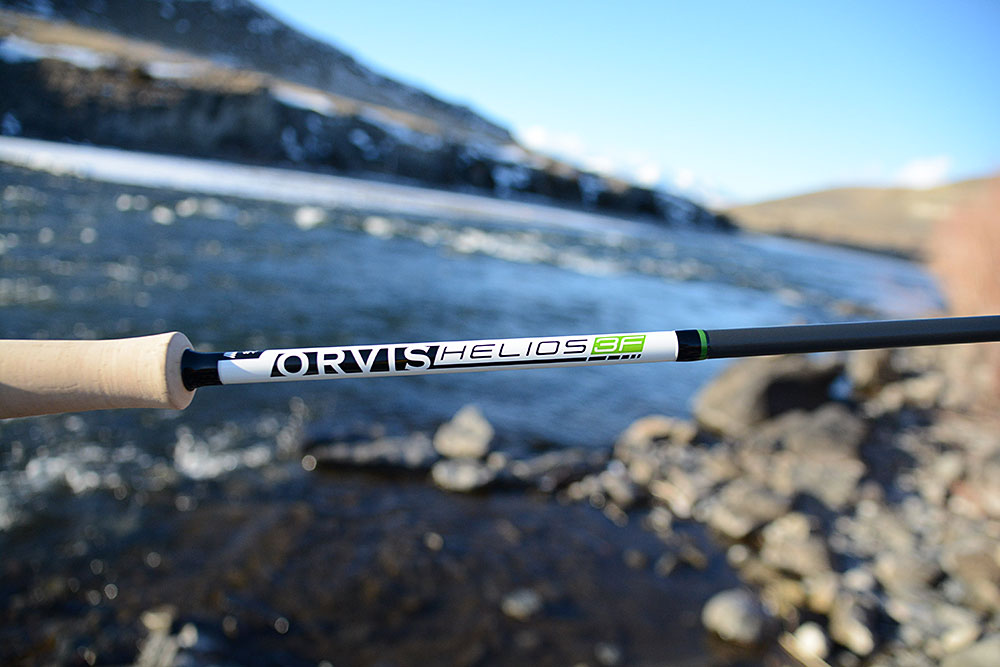
This rod is finished with a flat, non-glare gray, which I do like. The wraps on the guides are a very dark gray that looks black. The 3F in the insignia is done in green, with a green trim wrap, while on the 3D, this is done in blue. You’ll find alignment dots on each rod section, which is handy.
There is no hook keeper on either Helios rod but the size is marked just above the cork handle. The handle itself is a mini half wells, with a medium sized swell and a nice flare at the bottom. Orvis uses a stack of narrow and very high quality cork rings, typical of today’s best rods. If anything, the reel seat is a little drab for a rod in this price range, but certainly functional. On the 3F, Orvis uses a black anodized skeleton seat with a dark gray graphite insert that has the serial number of the rod on it. This is a single uplocking seat with a large double-wide locking ring and nylon insert giving a very secure lock up. The guide set up starts out with a large sized titanium stripping guide with a SIC insert. The rest of the guides are the best nickel/titanium snake guides.
The perfect line: S.A. Amplitude MPX in WF-6-F
George’s casting notes
Performance at 30 feet 19.8 out of 20
Very nice feel and terrific accuracy in close. Only the SKY G was better at short range. Impressive performance at our shortest distance!
Performance at 50 feet 19.6 out of 20
Still extremely good tracking and accuracy combined with delicate presentations. Only the Sky G and the two Loomis rods were better at mid distance.
Performance at 75 feet 18.9 out of 20
Now the lack of backbone hurt a little. Still pretty good but the short to medium distances are this rod’s forte.
#8. Hardy Shadow 9’ #6 $389.95
*Our Pick for Best Mid Priced Rod*

Here is an impressive 6-weight that wins the crown as our pick for the best mid-priced rod. The Shadow is somewhat softer than the best six-weights but still performed very well, even at longer distances. You can see on our deflection charts how it is a bit softer than other rods but it has a nice medium-fast action that seems just right and very forgiving.
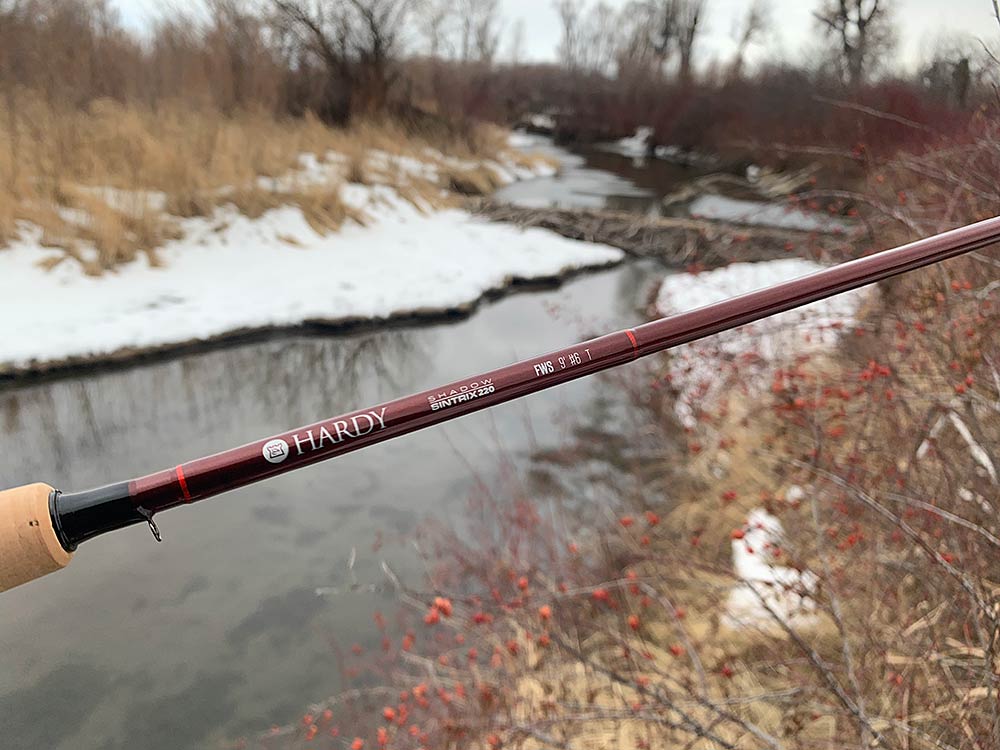
The new Hardy Ultralite that placed 4th in this Shootout, uses their latest in materials, Sintrix NSX. The Shadow uses a lower modulus (and heavier) Sintrix 220. Surprisingly, for overall weight, the Shadow tied with the Avantt for a perfect score. And the swing weight was lighter than anything other than the Sky G and Asquith! This light weight makes the Shadow a very pleasant rod to cast and fish all day, especially if you are fishing dries.
The Shadow is finished in a beautiful deep ruby metallic red. The wraps are very dark red, trimmed with some bright red on the butt section. Alignment dots are used. A half wells cork handle is composed of standard sized, high quality cork rings that are better quality that we see on a lot of other mid-priced rods. A black anodized, double uplocking skeleton seat is used with a very attractive burled wood spacer. The rings were a little hard to grip, but use nylon spacers to give a secure lock up.
Guides start out with a hook keeper and then a single SIC stripping guide, followed with dark colored, hard chrome single foot guides, not the better nickel/titanium single foot guides we found on Hardy’s Ultralite. The epoxy coatings were a little heavier than I’d like to see, but not objectionable.
The perfect line: S.A. Amplitude MPX in WF-6-F
George’s casting notes
Performance at 30 feet 18.8 out of 20
I’m getting plenty of feel, and can cast easily off the tip of the rod. My accuracy was as good as the NRX+ but not as good as the Centric or Helios 3F.
Performance at 50 feet 19.3 out of 20
Impressive tight loops that gave me very good accuracy. Even better than the Ultralite at mid-distance. I really liked the way the Shadow performed here for a mid-priced rod.
Performance at 75 feet 18.5 out of 20
Now the softer action doesn’t allow me to throw the same kind of tight loops as I was getting with the Ultralite. But the tracking is good and the accuracy is decent.
#9. Orvis Helios 3D 9’ #6 $949.00

As you read above, I felt that both the Helios 3F and 3D were great 6-weight rods. The main difference in the two is not so much the action as how the rod is set up. I like the 3F better as a freshwater 6-weight, but if you want a terrific 6-weight that you can use for fishing nymphs with indicators, or in salt water, then the 3D is a better choice. I liked the fighting butt, a better reel seat lock up that will handle a heavier reel better, and the larger full wells handle shape.
When I hold both rods in my hand and flex them, their medium fast action is nearly identical. The 3D has just a little more guts and power, which improves its performance at long range. On the other hand the 3F was better at short distances and you can see this in the scores at 30 and 50 feet.
These Helios rods are light in hand and throw impressive loops at all distances. They are also some of the best dampened rods we’ve cast, one of the reasons they are such smooth casting rods.
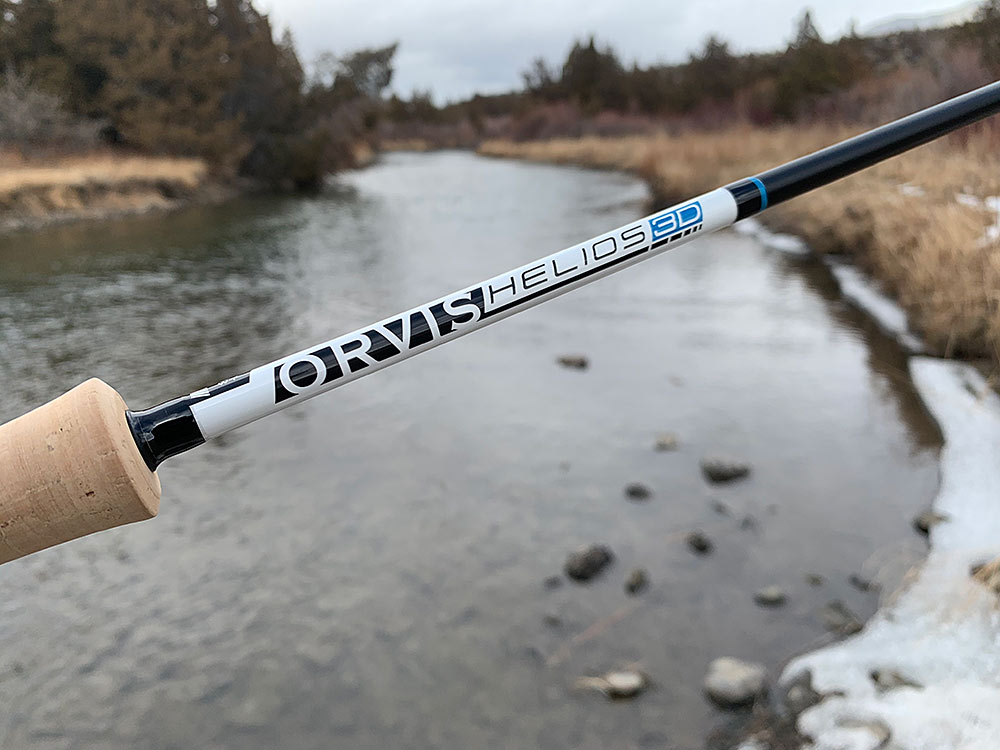
I also am getting a lot of feedback and feel with both the 3F and 3D, which gives me more confidence where I’m putting the fly. Accuracy with the 3D was excellent, especially at medium and long distance.
Craftsmanship has always been excellent on the Helios rods. As with the 3F, I’m not a fan of the 5 ½ inches of white ahead of the cork grip, displaying the Orvis logo, but this has become an Orvis Helios trademark now. The Helios rods really jump out at you on the rod rack. And out on water, or from boat to boat, you can tell instantly if that other angler is using a Helios rod.
The Helios 3D rod is finished slightly differently from the 3F, in that the overall finish is a flat black rather than a flat gray. I love these flat, non-glare finishes as you’ll spook fewer fish while casting, especially when the fish are close. The thread wraps on the 3D are black, and the 3D insignia is done in blue, with a blue trim wrap. The epoxy coatings were excellent. You’ll find handy alignment dots on each rod section.
Like on the 3F, there is no hook keeper on the Helios 3D. The rod size is marked just above the cork handle. The handle on the 3D is a larger full wells design with a slightly larger swell in the middle and a flare at both top and bottom.
Orvis uses a stack of narrow and very high quality cork rings as on the 3F. The reel seat on the 3D is much better suited to holding a heavier reel, or one you might use for salt water. This rod has another black anodized skeleton seat but on the 3D there are double uplocking rings that are large and easy to grip and tighten. Nylon washers on each ring ensure a very secure lock up that won’t come loose. A black graphite insert is used with the serial number of the rod inscribed. The 3D has a nice wide fighting butt. The fighting butt is 7/8 of an inch long and tapers out to 1 and ¼ inch. A rubber/cork cap is used on the end for durability.
Guides on the 3D start out with two large sized titanium stripping guides with SIC inserts (the 3F has only one), followed by the best nickel/titanium snake guides that are flexible but will never break.
The perfect lines: SA Amplitude MPX (best all around) or the SA Anadro/Nymph (nymph and streamer fishing),both in WF-6-F.
George’s casting notes
Performance at 30 feet 18.5 out of 20
Good, but the 3F was much better in close. Better than what I expected, since the 3D is a more powerful rod.
Performance at 50 feet 19.2 out of 20
A nice blend of both power and feel. The 3F was slightly better as were both Loomis rods and the Sky G.
Performance at 75 feet 19.6 out of 20
Now the power on tap takes over and the rod tracks beautifully, throwing wonderful tight loops. The Asquith and NRX+ were slightly better.

The Sonic is a new rod from Sage, and put in an impressive performance at a far less expensive price point than their Sage X, which is $950. In my casting, the Sonic actually outscored the Sage X, to make it into our top ten best 6-weights.
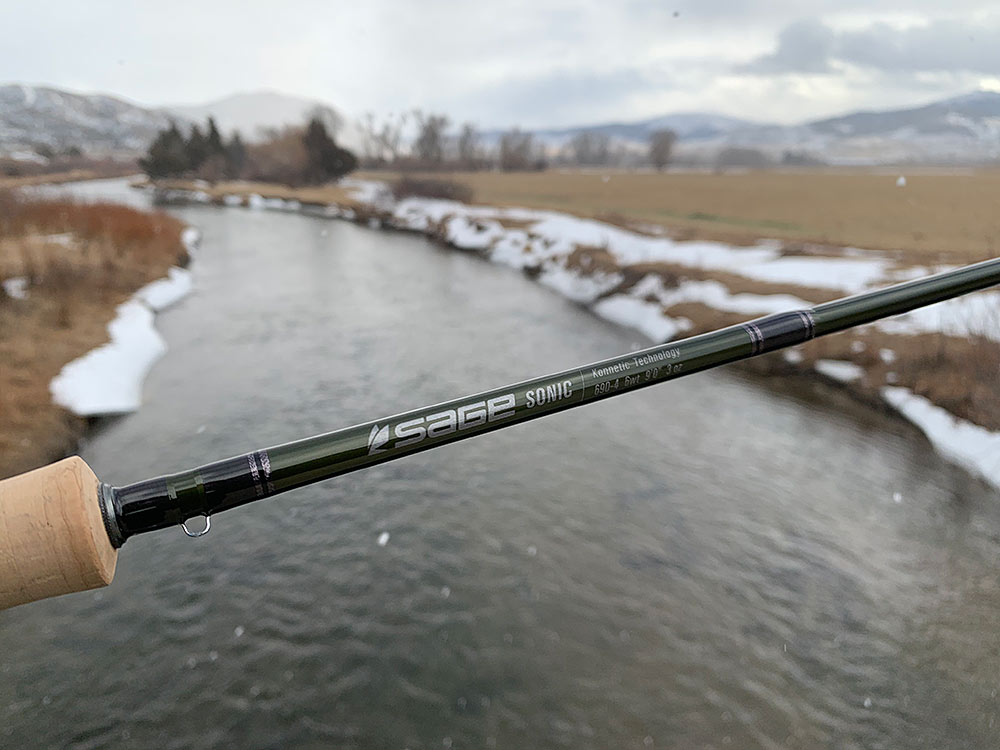
This is a rod that has a lot of beans, and is one of the more powerful 6-weights we had in our Shootout. Sage tells us that this is a fast action rod like the X, built using their same Konnetic technology. We heard rumors that the Sonic was built with the same butt and midsections as the X, but with a fiberglass tip section. In looking at the rod, I can see that the butt section is a little smaller in diameter than the X, so it certainly isn’t identical. In looking at the rod deflections, the Sonic is actually a little stiffer than the X and is one of the most powerful rods in our Shootout. It almost has as much butt power as the Asquith, which was fantastic at long range. The Sonic cast quite well at all distances, but mid to long range was the sweet spot.
The Sonic is another very attractive rod from Sage with superb craftsmanship that we’ve come to expect from Sage. The blank color is what they call Juniper – a dark olive. The wraps are dark brown, with gunmetal trim wraps on the butt. The cork handle is called a snub nose half-wells, which has a long thin swell, with a little flare at each end. I liked this grip a lot. The cork rings themselves are another stack of thin high-quality cork, that we see on a lot of the best rods. The reel seat is a matte slate gray anodized, single up-locking skeleton aluminum seat with a brown laminated hardwood insert. The single locking ring has a nylon ring that helps give the reel seat a nice positive lock up.
The guide set starts out with a hook keeper above the cork handle, then one medium sized Fuji ceramic stripping guide, followed with hard chrome snake guides. The epoxy coatings on the guides were good, but a little heavy in spots.
The perfect lines: SA Amplitude MPX (best all around) or the SA Anadro/Nymph (nymph and streamer fishing), both in WF-6-F.
George’s casting notes
Performance at 30 feet 18.8 out of 20
I like the softer tip that gave me a good amount of feel. Accuracy was pretty good for a stiff rod, and matched the NRX+.
Performance at 50 feet 19.6 out of 20
Nice, tight loops that are giving me pretty good accuracy, better than the Shadow and Avantt.
Performance at 75 feet 19.2 out of 20
Tracked well and felt solid at long distance. The 3D and Ultralite were better, and the Asquith and NRX+ were in a class by themselves.
*Almost Top Ten and Best Inexpensive Rod Overall

When I first picked up the Carbon XL and took a few casts I was thinking – for a cheap rod this really performs way above its price range! Although it is one of Echo’s least expensive rods, it still performs very well. Tim Rajeff has done a marvelous job of designing a medium-fast action 6-weight that performs well in a variety of situations. The XL stands for Extra Light. When I’m casting the rod it doesn’t feel all that light but it’s not objectionably heavy either. In our limited Shootout, it was the heaviest rod in both overall weight and swing weight, but the Carbon XL was still a lot lighter than others that didn’t make our top 10.
As Tim explains, this rod was designed to be an inexpensive but versatile rod, and in this respect he has hit a home run. If you are looking for an inexpensive 6-weight as a back up rod, or one for someone that is just starting out, you can’t miss with the Carbon XL.
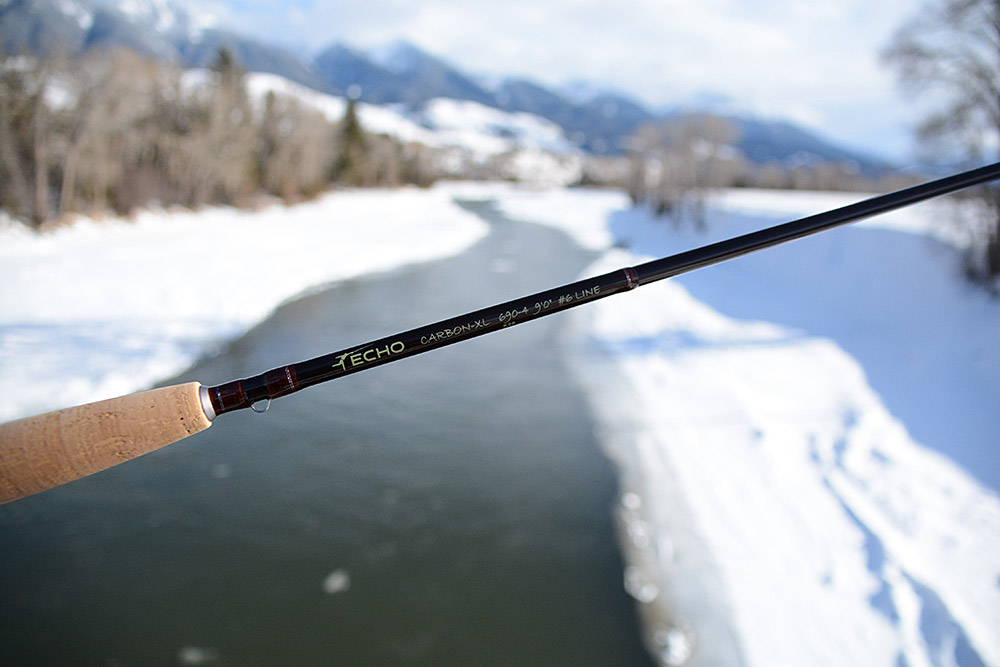
I was amazed at the accuracy and presentations of the Carbon XL, especially at our mid-distance of fifty feet. Here I rated it at 19.5, equal to the Avantt and almost as good as the Centric and the G.Loomis Asquith and NRX+!
Sure, it rated at the bottom for craftsmanship, but when you consider the price you cannot expect to get the best in terms of the quality of components, or cork in the handle.
Echo calls the color of the blank rosewood, (a nice medium brown), with reddish brown wraps, that are trimmed with a little gold on the butt section. The cork handle is a half-wells, and this is one of those pre-formed grips of lower quality cork that shows a lot of filler.
The reel seat is a simple gray anodized, single uplocking skeleton seat, using a reddish brown graphite insert. The locking ring was not as easy to grip as some and had no nylon washer.
The guides start out with a hook keeper on the butt, then two SIC stripping guides, with the rest hard chrome single foot guides. The epoxy coatings on the guides were really pretty decent, much better than I expected on this inexpensive rod.
The Echo Carbon XL is our pick for the best inexpensive 6-weight rod!
The perfect line: S.A. Amplitude MPX in WF-6-F
George’s casting notes
Performance at 30 feet 19.0 out of 20
Surprisingly good in close, even better than the Hardy Ultralite and Avantt! I was getting good accuracy combined with good feel provided by the softer tip.
Performance at 50 feet 19.5 out of 20
Very impressive tight loops and great accuracy. Heavier in hand than most, but not objectionable. Accuracy almost as good as the Helios 3F, the Centric, and the NRX+.
Performance at 75 feet 18.9 out of 20
Certainly enough power to go long, and as good as the Helios 3F, but didn’t have the guts to match the more powerful rods like the Centric, Avantt or the Loomis rods.
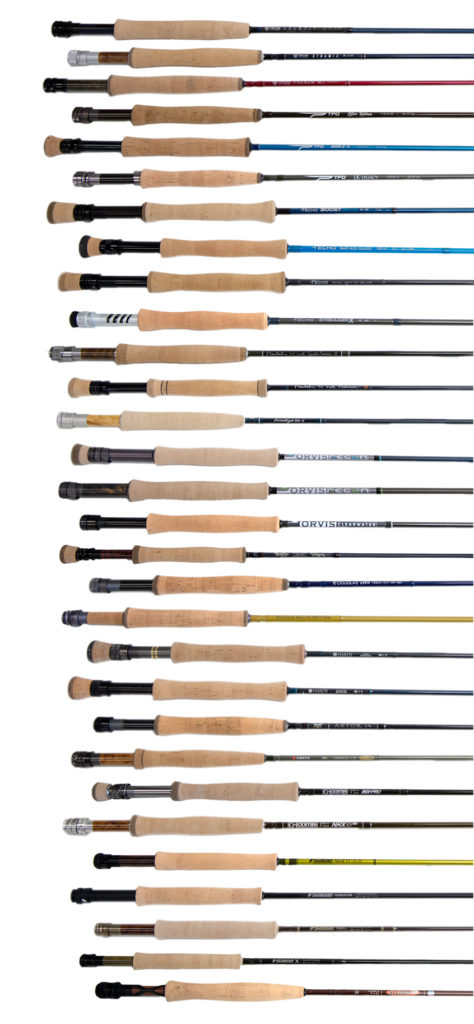
If you’d like to read more about the other 30 rods tested, we have prepared a PDF describing each rod’s action, performance and components. To gain access to this PDF you can call us, e-mail us, or click on the window below and we will e-mail you a copy of it.
If you are thinking about buying a fly rod, we suggest reading one of our Shootouts for the line size rod you want. You’ll find these on our Yellowstone Angler home page at yellowstoneangler.com.
Call us at 406-222-7130, or e-mail us at staff@yellowstoneangler and we can discuss your needs and wants. I’m confident that we can come up with the perfect rod or outfit for you.
If you are getting one of the Ultimate 6-weight outfits, we’ll throw in a SA Mastery MPX line for free (a $79.95 value). If you would prefer the Amplitude MPX, which are normally $129.95, we’ll upgrade you for an additional $50.00. We’ll also ship it to you for free, and since we are in Montana, there is no sales tax.
Once you get your new rod or outfit, do some casting on the lawn, and if you feel it is not just what you want, (and has not been fished), we’ll allow you to return it to us for a full refund, less the shipping charges.
Use this link to go to our Favorite Freshwater Outfits for the 3 through 8-weight rods, in our Online Store. Here you’ll find our recommendations in three price ranges: The Ultimate Outfit, Mid Priced Outfit and Best Buy Outfit.
If you are looking for that perfect saltwater outfit, then check out this link for our Favorite Saltwater Outfits.
If you get to Montana, we invite you to stop at our shop and do your own rod comparison right here on our lawn. We have several reels rigged with the various line sizes, and leaders, all ready to go. We’ll come out with you and give you some help to fine tune your casting stroke, or just help you with the basics. And once you’ve picked out the perfect rod, stay and enjoy a few days on the water with one of our top guides.
The best fly rods are not always the most expensive
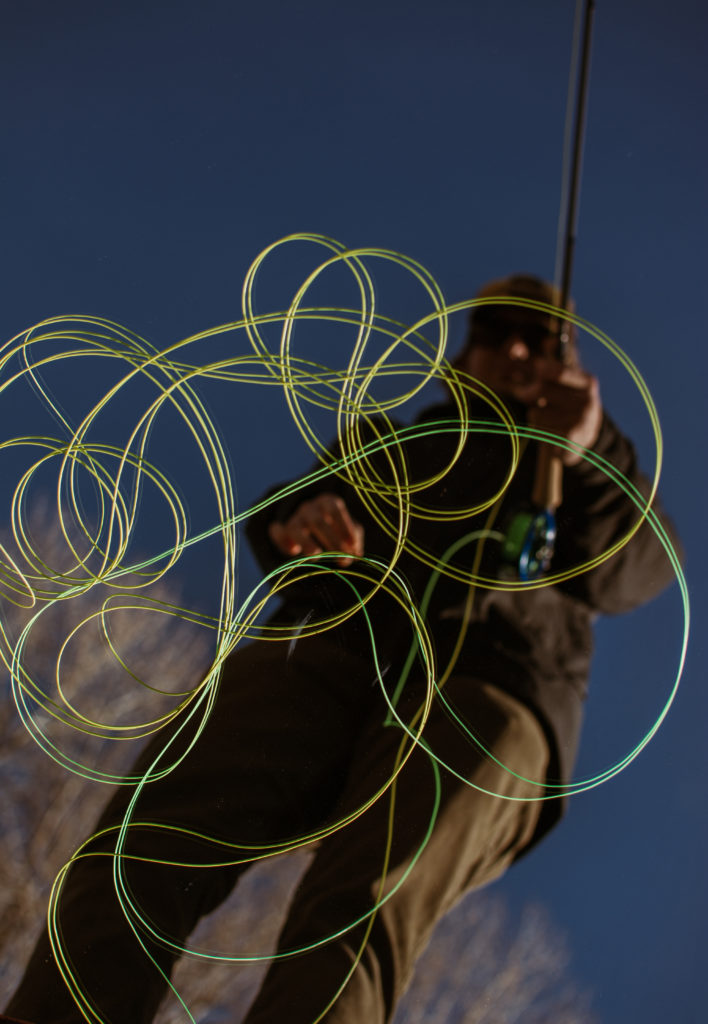
As we have found in past Shootouts, there are some outstanding rods that score higher than rods that are two to three times as expensive. A good example of this in a mid-priced rod is the new Hardy Shadow at $389.95. Overall, it finished higher than the Orvis Helios 3D that sells for $949.00. If you want the best, you’ll likely be looking at spending $795.00 or more. Is that high priced rod really worth the difference in price?
If you are just starting out or not planning to do much fly fishing, then one of the inexpensive or mid-priced rods may be the best choice. For experienced anglers that can afford the best rods our advice has always been that if you can afford the best, buy the best. You’ll never regret it.
For beginning anglers, buying one of the best rods will allow you to advance more rapidly in both your casting and flyfishing. In my experience, the key to catching fish is casting accuracy. Having a nice light rod, (in swing weight), in your hand all day pays big dividends, in terms of fatigue. There is certainly a wow factor too with an expensive rod, when you pull that rod out of its case in front of your fishing buddies. The best rods have almost become a status symbol. Are you comfortable fishing with a $200 rod when all your friends have those hotshot $750-$1100 rods? It’s also nice to look down at your rod and reel and appreciate the craftsmanship and function of one of the very best rods.
We see a lot of people wishing to economize getting into fly fishing and buying less expensive equipment. Then, as they immerse more deeply in fly fishing, and try some of the best casting rods, they realize that the higher priced rods make casting so much easier, and will allow them to improve more quickly. At that point, they often do buy a more expensive outfit, and essentially end up throwing away the money they spent on the cheaper outfit. While they can hand the outfit down to a friend or family member, the smart thing to do is buy the right rod initially, saving money in the long run.
We hope that this 6-weight Shootout helps you to choose the very best rod for your needs.
Great anglers design the best rods
Over the past 50 years, it has become apparent to me that the best rod designers are people that are also great anglers. From their fishing experience, they know just what is needed for specific fish, the fishing conditions, and techniques needed to master a fishing situation. They can take a basic design and fine-tune it to perfection, making a few tweaks and design changes along the way to end up with that perfect rod the situation and techniques demand. A lot of friends come to mind. Fellows like Steve Rajeff (G. Loomis), Howard Croston (Hardy), and Fred Contaoi at Douglas are guys I’ve spent time fishing with on small streams, and big rivers. Then there are a lot of other guys I know that are also great anglers like Jerry Siem at Sage, Jim Bartschi at Scott, Tim Rajeff at Echo. When you pick up and cast one of their rods, it is apparent that they know exactly how each line size rod should perform.
As in our past Shootouts, we know how important it is to make an effort to eliminate any variables. This means setting up the rods with the exact same reels, amount of backing, lines and leaders. For this 6-weight shootout, we had ten identical Galvan Torque reels set up with our favorite 6-weight line, the Scientific Anglers Amplitude MPX. This line is a half-size heavy, that matched up well with these more powerful 6-weight rods. For leaders, we used our own Yellowstone Angler 9 foot 4X Clear Butt Leaders. These are tied with Clear Maxima butts and mid-sections and Rio tippets. They cast and turn over better than any of the knotless leaders on the market. Rather than a fly on the end we use a fluorescent yarn indicator, clipped short so that it will turn over much like a medium sized dry fly. Then before casting, we stretch out the fly lines and leaders so that they will cast and turn over perfectly.
By setting up all the rods in an identical manner, it is easy to take a few casts with a rod at one of the distances, then quickly pick up another rod and do the same. This is the best way to determine subtle differences between rods. I’ll usually try to compare 2-4 rods at each distance and once I determine the very best casting rod in each price category, I’ll keep that in the mix and compare all the other rods to this one. I’ll usually start out at our middle distance, 50 feet, to get the feel of each rod at a distance I’m fishing most of the time with a 6-weight. Then I’ll try them at 30 feet, and finally, out long at 75 feet. Having multiple outfits set up makes these comparisons easy. I’ve found that taking the time to strip all the line out of the guides and load up another rod takes too long and makes these comparisons more difficult.
In our casting, we’ll identify the best performing rods first, which are typically in the highest price category. Then, we’ll move on to the medium priced rods and finish off with the inexpensive rods.
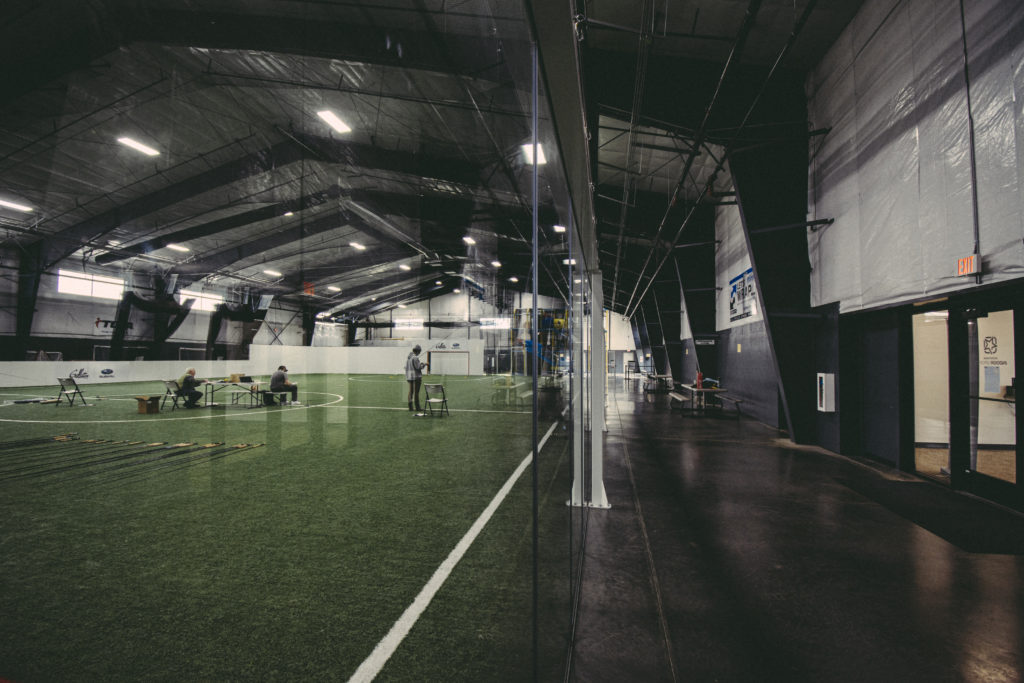
Eliminating the biggest variable – the Livingston wind!
This year we had to put off our casting until January, in order to get all the newly released rods from the manufacturers. Doing the casting outside was difficult if not impossible with the cold and gusting Livingston wind! Gusting wind is the worst and makes judging longer distance accuracy almost impossible. In the past, when casting outside was impossible we have used the gym at our Civic Center here in Livingston, but this limited distances and presented back-cast problems with hanging bars and wires. This year we found a much better place to do our indoor casting in Bozeman, out near Four Corners, called Montana Indoor Sports. This was ideal, with a much larger casting area covered with synthetic turf, that is used primarily for indoor soccer, football, and lacrosse. Now we had enough room to set up 4-5 casting lines right out to 80 feet.
In picking the right reel for our 6-weight Shootout, we once again selected the Galvan Torque. These are wonderfully light reels, and have a very smooth drag that is easily adjustable through a wide range. I also love the large drag knob that is easy to grip and adjust. We’ve found that the Galvan Torque reels also have a wider range of drag adjustment than most other reels, making it easy to fine tune the adjustment, which is especially important when you are using light tippets like 5X and 6X. Much of the time when I’m fishing dry flies, and hooking smaller trout, I’ll just strip the fish in, but if I hook a larger fish I’ll try to play it off the reel, using the drag. When I’m fishing nymphs or streamers with heavier tippet like 2x-4x, then I’ll want to play the larger fish off the reel most of the time, and this requires a smooth drag that can be adjust quickly and easily.
Rather than choose a Galvan Torque 6 for this Shootout, we decided to use the Torque 5, which has plenty of backing capacity and is lighter. This reel won our 2016 5/6 Reel Shootout. With the SA Amplitude MPX in WF-6-F, we could easily load 90 yards of 20 lb. Cortland Micron backing, and not jam up the reel, (which is plenty for most 6-weight fishing situations). Using a T-5 kept the weight down to a light 6.1 ounces, with the reel fully loaded with line and backing. For those of you that need more backing capacity, then by all means, go up to the T-6. With the same WF-6-F Amplitude MPX and 20 lb. Micron backing, now the capacity jumps up to 180 yards, but the overall (fully loaded) reel weight goes up to 6.9 ounces. For those of you that want to use your 6-weight in saltwater, especially for bonefish, you’ll need that much backing. You’ll also want to pick one of the 6-weights with a short fighting butt. Although we have found that the Galvan Torque reels perform well in salt water, if you would prefer having a sealed drag, you can step up to their Galvan Grip reel.
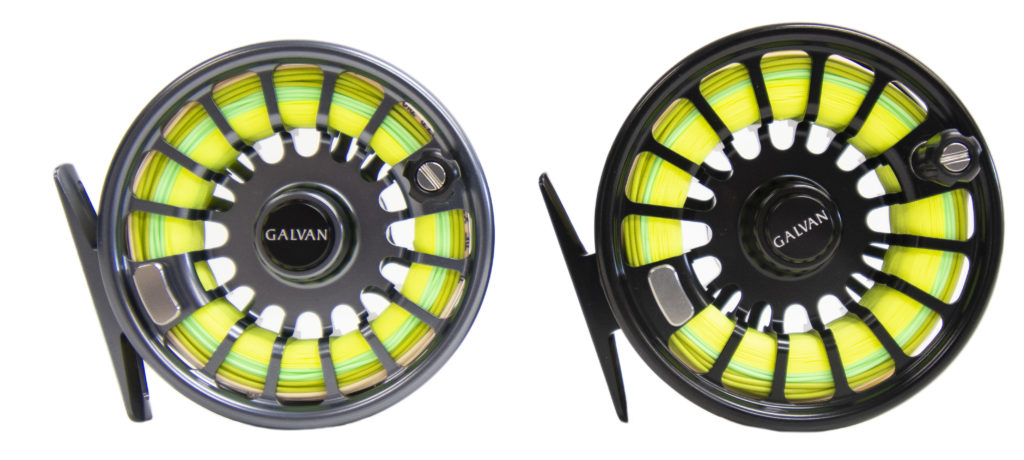
If you are looking to economize, especially on the mid-priced and best buy outfits, you can save about a hundred bucks by picking the Galvan Rush Light reel, which comes in the same sizes and has the same smooth drag and backing capacity. The main reason the Rush costs less is simply because it takes Galvan less time to machine it.
Removing the spool on the Galvan reels is easy – just a simple click of the spool release button on the handle side. I also like the handle design – it tapers outward, allowing you to quickly get and maintain a solid grip. Galvan uses a counterbalance so that the reel runs perfectly smoothly when that big fish is smoking away from you.
The Galvan reels are delightfully maintenance free, with Rulon bushings that require no maintenance or lubrication to keep them working properly.
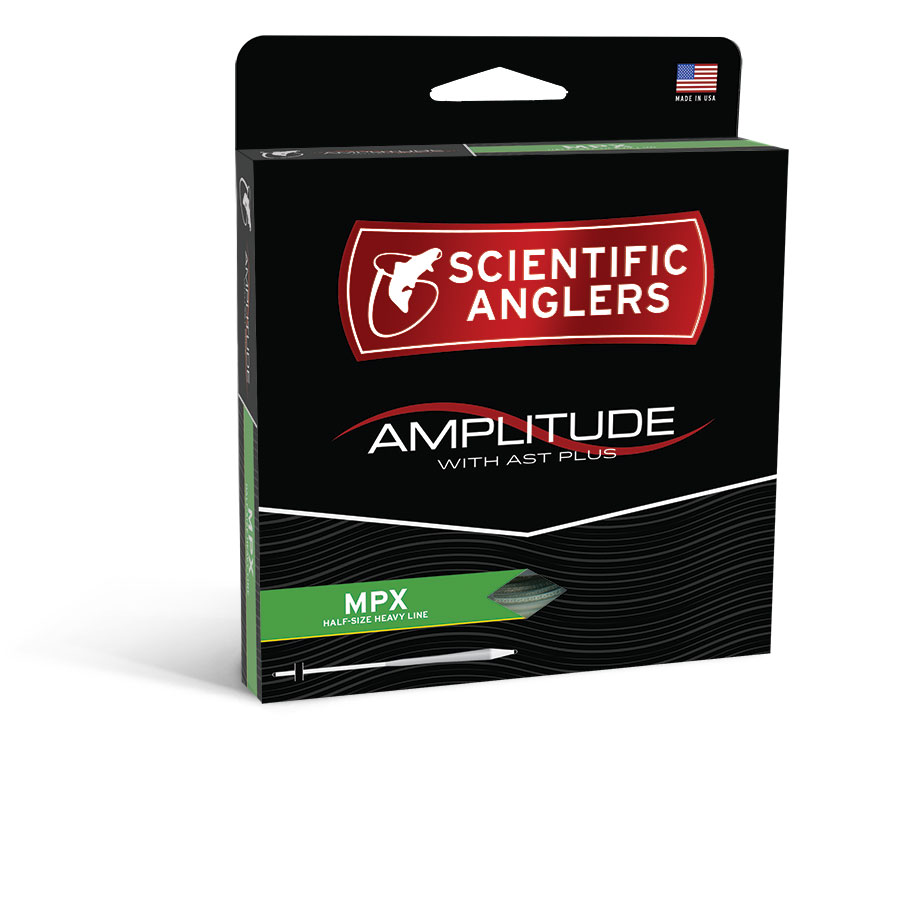
We have been Scientific Anglers line fans for years, and their Amplitude MPX line is a perfect choice for these 6-weight rods. This line is a half-size heavier than a normal Trout taper. The Amplitude MPX in WF-6-F has a total head length of 36 feet with a 6.5-foot front taper that allows for a quick turnover in the wind. The MPX is especially good with larger, more wind resistant flies like hoppers and stonefly dries. The Amplitude MPX uses a floating texture on the tip section for the ultimate in floatation and a textured running line behind the head that delivers longer casts, especially with SA’s AST Plus slickness additive. These Amplitude MPX lines shoot like crazy! The Amplitude MPX is a ninety foot three colored line – the 8 foot tip is buckskin, followed with a 35 foot belly that is moss green, and then the rest a running line that is a brighter optic green. Having the difference in colors between the head and running line allows you to judge how much line you have out of the rod in the air, and when casting longer distances using a double haul.
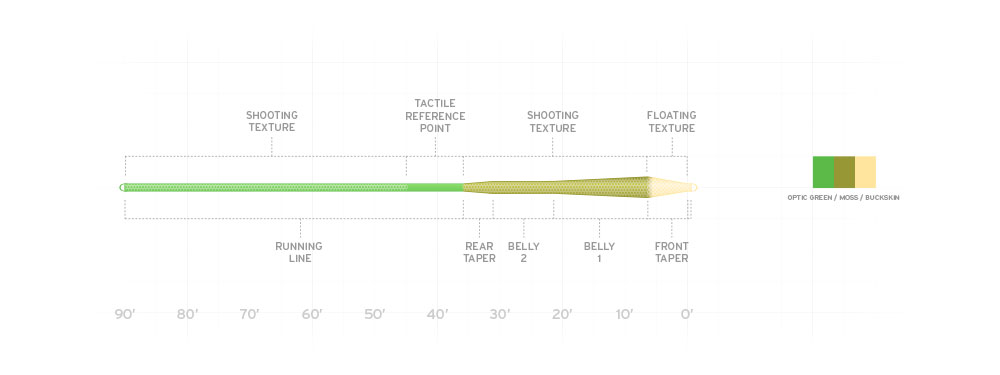
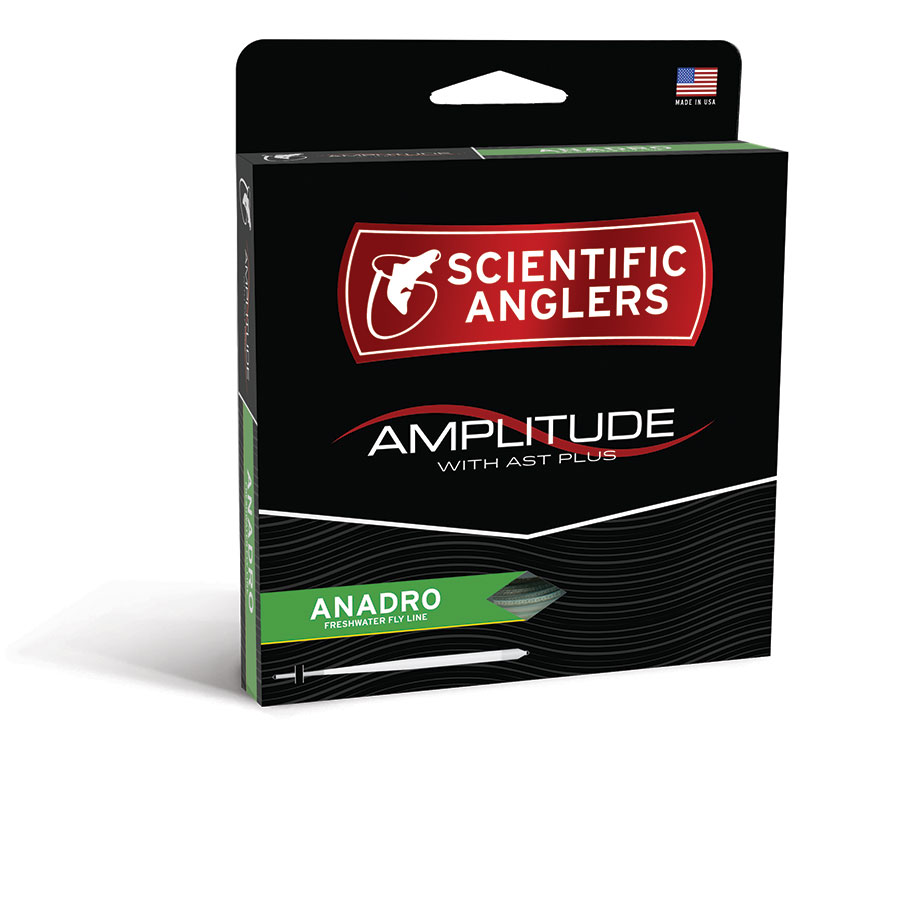
If you are doing a lot of nymph fishing with an indicator or fishing large dry flies like chubbies or hoppers with a nymph dropper, another good choice for the more powerful 6-weight rods like the Asquith, NRX+, and Sage Sonic is the SA Anadro/Nymph. This line has a heavier 60-foot head and a short front taper that makes turning over heavy rigs much easier, as well as an uncanny ability to cut through the wind. The Anadro is overweighted by 1.5 sizes to assist in turnover heavier rigs, compared to the Amplitude MPX, which is just a half size heavy. Other rods that didn’t make our top ten that felt better with the Anadro were the Loomis IMX Pro, the Echo Streamer X and the Hardy Zane Pro. If you are using your 6-weight for a lot of dry fly fishing, then stick to the Amplitude MPX, but if your 6-weight is going to be a nymph fishing workhorse for you, consider the Anadro line instead.
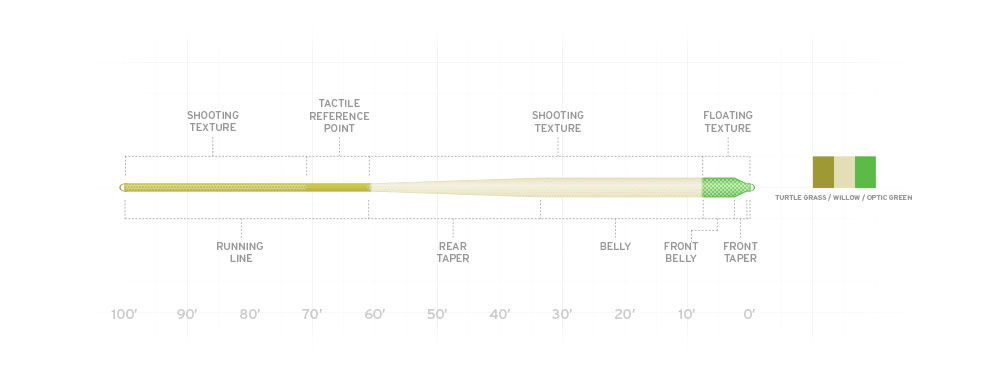
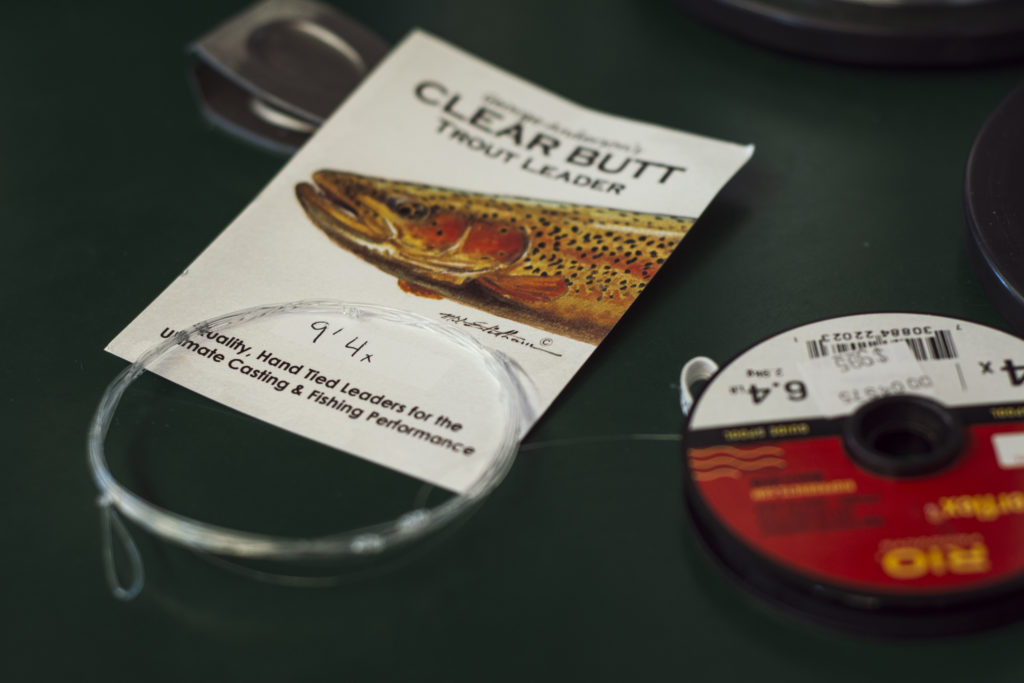
As in the past, we prefer to set up all the test lines with our own Yellowstone Angler hand-tied leaders. For this 6-weight Shootout we used our Clear Butt 9 foot 4X leaders. These utilize clear Maxima butt and midsections with Rio nylon 4X tippets. Our hand-tied leaders turn over better than any of the 9 foot knotless leaders we’ve found. For most of the fishing we do with a 6-weight rod a 9 foot leader is the best choice, often with a 3X or 4X tippet. When I’m nymph fishing I’ll switch over to one of our Hot Butt leaders that utilize a butt section of fluorescent red Amnesia that is easy to see. Since these use the same formula as our Clear Butt leaders, I’ll often use the Hot Butt leaders even fishing dry flies.
If you are fishing in more difficult conditions, with spooky fish, then you might want to shift up to our 12-foot Clear Butt leader with tippets down to 5X and 6X. With larger wind-resistant hoppers here on the Yellowstone River, our guides are normally using a 9-foot 3X leader, or even a 7.5-foot leader when fishing with beginners. For our 6-weight Shootout casting, we tie on a fluorescent yarn indicator that approximates the wind resistance of a medium size dry fly, enabling us easily to judge turnover and accuracy, right out to 75 feet.
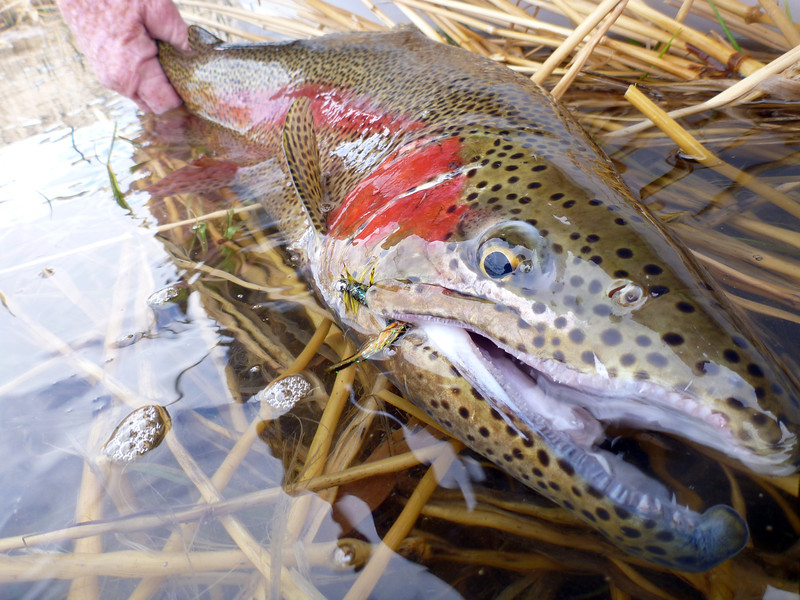
Our deflection charts have been so popular that we have worked up more for this 6-weight Shootout. These allow everyone to see exactly how each rod bends compared to the others. If you click on one of the charts, it will enlarge it, so that you can more easily see the differences in flex between rods. One thing that we notice is that most manufacturers today are now using similar flex patterns compared to what we saw just a few years ago.
Now you can easily see which rods have faster actions than others (the tip bends more) or ones that have more moderate, slower actions (the tip bends less steeply). To make the deflection chart, we placed the rods at a 45-degree angle and then hung a weight of 4.5 oz. from each tiptop. Then we traced the outline of the rod in different color sharpies.
Keep in mind that fast action rods are not necessarily stiff rods. The tips on the faster action rods bend more, and if you look at the top rods, you will see that they tend to be faster action rods. We have found that this is the key to getting good accuracy in close. On the other hand, the best rods must have enough butt and mid-section power to throw longer distances with ease.
You can pick a rod off the rack in a fly shop, flex and wiggle it with your hand and get an idea of how it might perform, but the proof is what it will do when matched up with the correct line and then compared heads up with other rods. Only then do the subtle differences reveal themselves, and this is what we are doing for you in our Shootouts.
George’s observations on the deflection charts
Today the deflections of our top 11 rods are much more similar than they were ten years ago. Manufacturers have learned that to cast well at all distances, fly rods need to have strong butt and mid-sections, but with softer, more flexible tips in order to get good performance at both close and long range. All the best rods we tested have medium fast, to fast action profiles.
Of all the top 11 rods, you can see that the Sky G has the stiffest butt section, but then one of the softer tips (the tip bends more). Look at the Sonic, NRX+, Asquith and Ultralite – they have very similar deflections and are more powerful than the other Rods. This is why they all perform so well at mid to long distances.
George’s observations on the deflection charts
Here you can more easily see the softer tip of the Sky G, in comparison to the NRX+, Ultralite and Asquith, which gives it better feel and accuracy in close at 30 feet.
Note that the Centric and Avantt are quite a bit softer in the butt and mid-section than the other rods and this is why they don’t perform quite as well at long range as our other top rods.
George’s observations on the deflection charts
Look how similar the softer tips of the Sky G and the Helios 3F bend. Both of these rods have an almost identical deflection profile. This is why both performed exceptionally well at 30 feet. Again I notice how much stiffer the tips of the NRX+, Ultralite and Asquith are, and this is why they performed better at long distances than other rods.
Below you will find the figures for price, overall weight, swing weight, and country of origin in our Objective Observations table. The first Objective Observations chart shows you our top ten 6-weight rods in finishing order, (plus the Echo Carbon XL – our pick for the best inexpensive 6-weight). A second Objective Observations chart can be seen below that lists the rest of the rods we cast in alphabetical order.

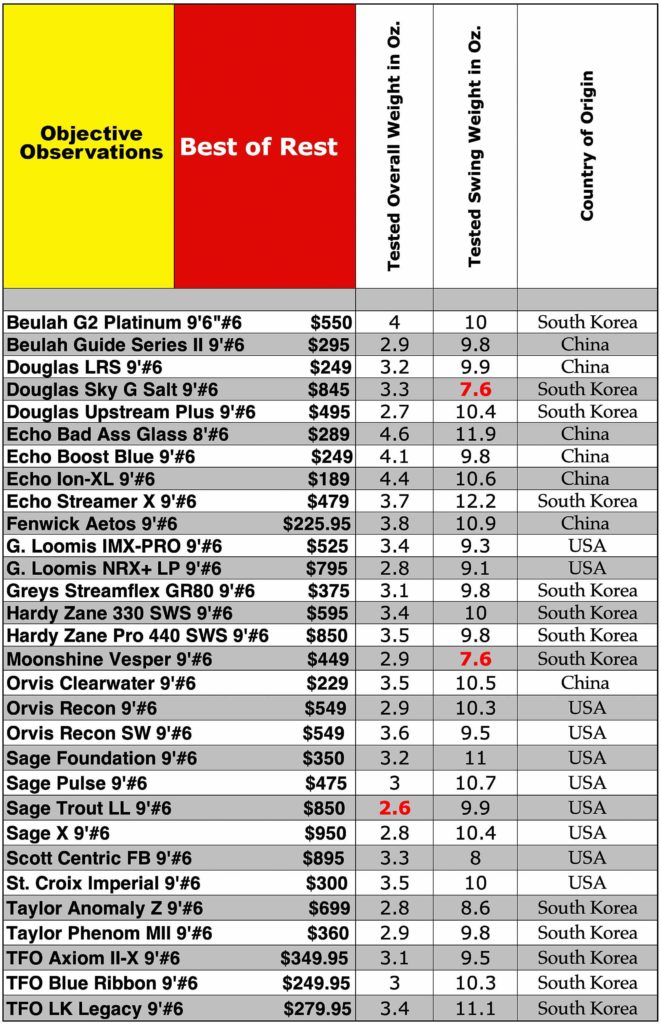
Price in US $$ – 10 points available
This is simple – the lower the price, the higher the points. The Echo Carbon XL at $169.00 got the perfect score of 10, while the highest priced rods like the Asquith and the Orvis 3F and 3D got 7.5 and 7.8. Rods that were $795 got an 8.3, while rods at $895 were an 8.0. Our pick for the best mid-priced rod, the Hardy Shadow at $389.95, gets a 9.5.
Craftsmanship – 10 points available
One thing that all of us here in the shop have noticed is how much fly rod craftsmanship has improved over the past several years. We look at many things to determine craftsmanship – the types of guides used, the quality of the stripping guides, the quality of the cork used in the grip and the way the wraps are finished. All are important. The flexible and unbreakable nickel/titanium single foot and snake guides are lighter and better than hard chrome snake guides, but they are a lot more expensive. Most manufacturers are now using one-coat epoxy coatings over the guide wraps, but if they are not very carefully applied, they can be sloppy and this adds unnecessary weight. For perfection in both wraps and coatings, the T&T rods are in a class by themselves. They use multiple coatings, carefully applied.
The quality of the cork in handles varies enormously in fly rods. Most of the top rods are now using a stack of thinner cork rings with almost no defects that are laid up and sanded down to perfection. Almost all of the rods in our top ten have extremely high quality cork. Only the inexpensive Echo Carbon XL uses one of the pre-formed cork grips that exhibits a lot of filler.
Reel seats should lock up easily and hold firmly, without having any tendency to come loose. The rings should be easy to grip and tighten, and the best ones use thin nylon spacers on the upper side of the rings, that help assure a positive lock up. Attractive wood insert reel seat spacers that are beautifully finished also add a lot to the aesthetic value of any rod. Although the Asquith, Centric, and Ultralite use single locking rings with nylon inserts, they all gave us a very positive lock up. Of all the reel seats, the one on Hardy’s Ultralite is the most unusual and attractive.
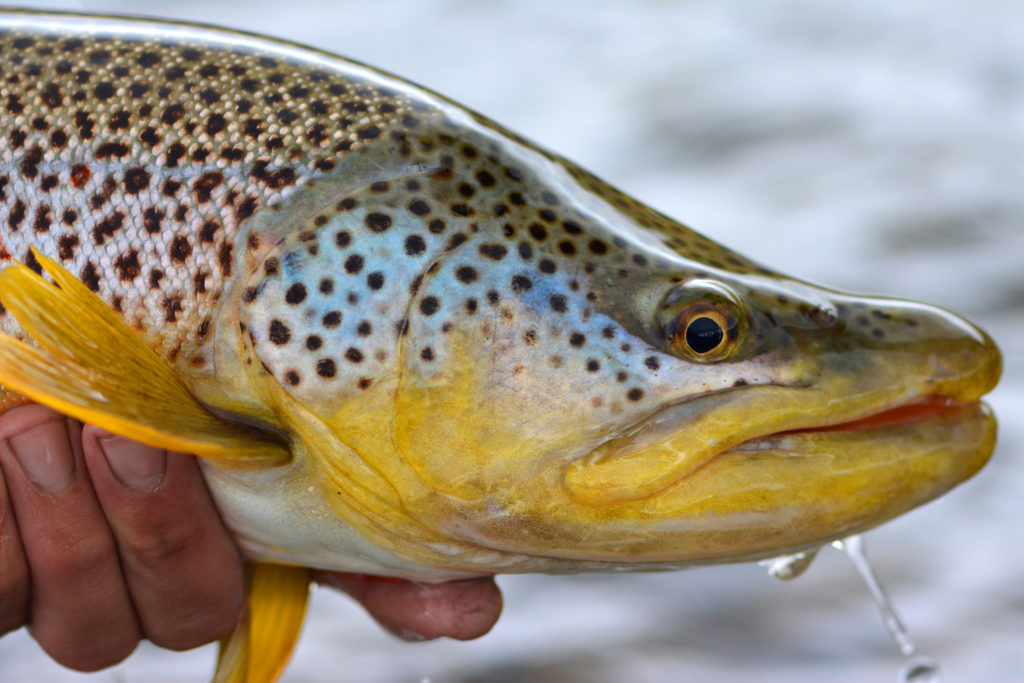
This year we gave out perfect scores for craftsmanship to only the Loomis Asquith and Thomas and Thomas Avantt. But the Scott Centric and Hardy Ultralite were right on their heels at 9.7. Several other rods like the Douglas G, Loomis NRX+, and the Orvis Helios 3F and 3D were all excellent at 9.5. The Hardy Shadow and Sage Sonic rated a 9. The Echo Carbon XL, at the low price of $169, rated an 8.
Warranties – 10 points available
We looked at all the warranty policies in detail as some have changed slightly. Every manufacturer now has some kind of “Lifetime warranty. Nearly all are charging a “handling” fee of $35-$100 to repair or replace your rod. And it is going to cost you another $10-$15 or more to ship the rod in for repair or have your dealer do it.
To my way of thinking, the most important thing when you break your rod is getting it back quickly, not so much the price you’ll have to pay. In this regard, G. Loomis continues to utilize their popular Expeditor policy. G. Loomis will charge your credit card $125 but you get a brand new rod back in 3-4 days. For the Asquith it can cost you $275, but Loomis is now allowing you to replace an Asquith tip section for just $75.00, and you don’t have to send the rod in. G. Loomis tells us that 90% of the Asquith breaks are in the tip. In the few instances where Asquith rods have broken, we have often not been charged for the repair at all, as G. Loomis took a look at the rod and decided it was a manufacturer’s defect. I think that most anglers will gladly pay for this Expeditor service if they can get a new rod back in just a few days. Loomis gets the perfect score of 10 for the NRX+, as does Douglas and Echo for their less expensive replacement charges and quick turnaround.
As you’ll see, most rods got a 9 or higher, which means that it costs $50 or less for the repair or replacement. In many instances the companies repair your rod and don’t give you a brand new replacement.
Farther down in our Shootout, just above the final results charts, we’ll give you the latest details on each manufacturer’s warranty policies, repair and replacement prices.
Fun to Fish/Got to Have – 10 points available
If the rod looks like a million bucks and casts like it too, any normal fly fisher will lust for this rod. For many, the most expensive rods may be seen as a status symbol. Others, who see how this rod performs in their guide’s hands think that it is going to make them great anglers too, or at least take them to the next level. Surprisingly, this is often true. Great rods don’t make great casters, but they can sure help an average caster get a lot better in a hurry. We have no doubt that the higher rated rods here will improve any angler’s casting skills and his ability to catch fish.
Don’t let the price slow you down. You’ll find a way to sneak it into your stash without the Mrs. (or Mr.) finding out. Since we eliminated the Perfect 6 performance category that rewarded what we felt was the best overall 6-weight, this category more or less does the same thing. All the rods rated 9.8 or better here are ones that we feel are really outstanding, and we’re convinced you will be delighted with any of them.
Overall Weight – 10 points available
As in the past we are using our reliable Brecknell digital postage scale, and round off to .01 of an ounce. We don’t take the manufacturer’s word for stated weight, (although this year most of these checked out to be true or very close). Lighter is better here, but this factor is not nearly as important as swing weight. In the past we’ve seen manufacturers cut overall weight by reducing the weight of the butt section only. This actually hurts the rod’s swing weight.
Swing Weight – 20 points available
You know about swing weight, if you play golf. It is the relationship of the club head to the shaft when you wiggle the club. With a fly rod, the swing weight is the weight you feel out ahead of your hand, when the rod is held horizontally. A little wiggle helps you feel this. Rods with a light swing weight are delightful and effortless to cast and fish all day. Rods with a heavy swing weight feel like a brick in your hand, and will wear you out casting them all day.
Measuring swing weight on a fly rod is not quite as easy as with golf clubs. We have experimented with various ways to measure swing weight in past Shootouts, but we still prefer our tried and true approach using the postal scale. This produces believable and meaningful results, and gives us a good way to rate one rod against another
How we measure Swing Weight of a fly rod
Here’s how we do this, as this is easy to do yourself with a little practice. First you must zero out the scale, (we use a Brecknell postal scale that measures in tenths of ounces). Then a foam-packing pellet is placed on the center of the scale. The reel seat rings and band are placed at the bottom of the reel seat. Now we position the grip over the fulcrum created by the foam pellet so that the pellet is positioned under the midpoint in the swell– where you will naturally grip the rod. With the Scott rods the fulcrum was slightly farther up the grip.
When the rod is placed on the foam pellet, the tip will naturally point towards the ground and the butt cap (or fighting butt) will be elevated. We then apply downward pressure with our finger to the butt cap (or fighting butt) to bring the tip (and butt) parallel to the floor. Then we read off the weight of this pressure on the scale in ounces. This is repeated a half dozen times, zeroing out the scale each time. Then we take the average of these measurements and this becomes the swing weight. We have found that to obtain accurate measurements, all this must be done the same day, at the same temperature, and within a period of less than one hour.
To an engineer this may not seem precisely accurate, but as a practical way to measure swing weight, we have found that it works fine. The most important thing here are not the actual figures, but how the rods compare with each other. Swing weight is such an important category, we now give it 20 points and consider it a part of our performance evaluation.
Check out the video below, from out 2019 Four Weight Shootout, for a visual explanation of measuring swing weight.
Indicator Nymphing – 20 points available
This is a new performance category for our 6-weight rods. All these rods in our top ten make very capable nymph fishing rods, but the more powerful rods with stiffer butt and mid-sections really shine when you are throwing nymph rigs with multiple flies, indicators and even split shot. Not only do these more powerful rods turn over a heavy nymph rig better, but they also are better at setting the hook quickly with authority. Rods that score high in this category are also better for fishing streamers with sink tip lines, and have the backbone to help you land larger fish more quickly on heavier tippets.
Performance distances for the 6-weight rods
We decided to use slightly longer distances for the performance evaluations for these 6-weight rods – 30 feet, 50 feet and 75 feet.
In our 5-weight Shootouts, the distances have been 25 feet, 45 feet and 70 feet. Then in our 8-weight Shootouts, the distances are 35 feet, 60 feet, 80 feet and 100 feet. We feel that these correspond closely to the distances that most people will be fishing these rods.
Performance at 30 feet – 20 points available
A rod’s ability to make delicate and accurate presentations with small flies and long leaders is the key to scoring well here. Casting accuracy and feel are the most important factors I use in rating these rods at the two closer distances. And a big part of accuracy is the feel you get through the handle that gives you the confidence to put the fly where you want it. I’m convinced that the key to catching more trout, and especially larger trout, is casting accuracy. Fly selection is far less important.
Does the rod load well in close, giving you the feel and accuracy you need with a short length of line and leader out of the guides? 90% of the dry fly fishing I do is at distances from 25- 40 feet. At shorter distances, I like to cast off the tip of the rod, using mostly my wrist and very little arm movement to power the tip of the rod through the stroke. The best rods here are almost always the lightest in swing weight, especially when you are doing a lot of false casting, as you often are fishing dry flies.
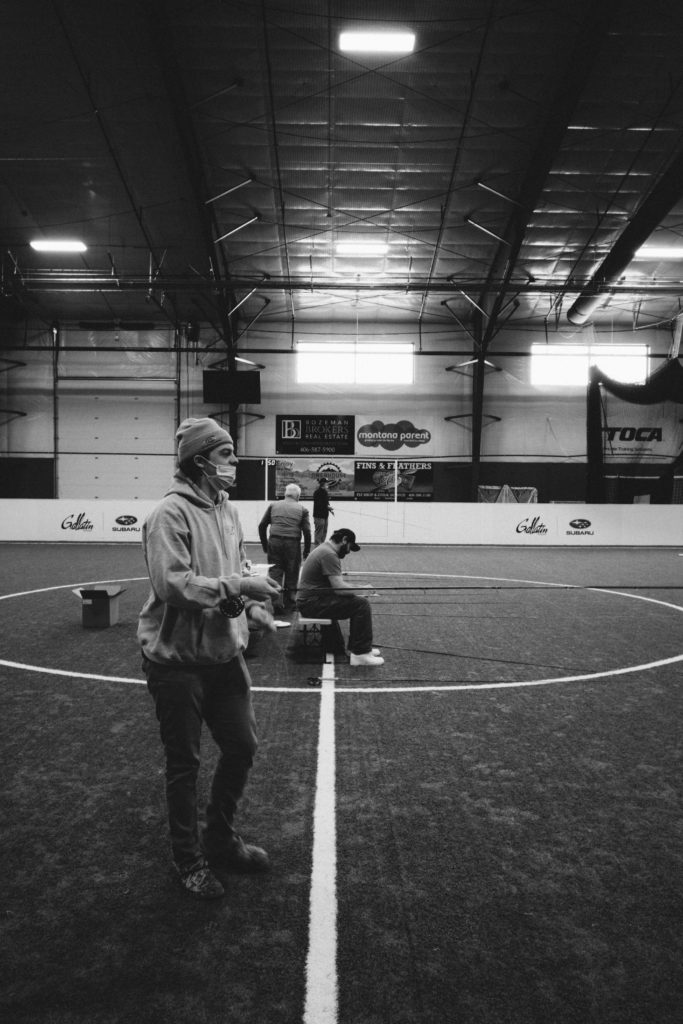
Performance at 50 feet – 20 points available
Here is the most important of all the performance categories for picking the best all around 6-weight rod. At 50 feet you want a rod that will be light and smooth enough to do a lot of false casting, which you will do fishing dry flies like hoppers all day long. At 50 feet, you shouldn’t have to double-haul to get the rod to perform. The best rods will have the ability to carry a lot of line in the air, and throw very tight loops at this range with consistent accuracy. They should feel totally solid at this distance and the line should track perfectly. With the best rods, a good caster can place a dry fly (in our case an indicator) within a foot or two of the exact target (for our Shootout, a paper plate) on most casts, unless there is a lot of wind.
The best 6-weight rods need to have excellent loop control and the ability to throw very tight loops to get the best accuracy and presentation, and do it even in a strong breeze. But they should also be able to easily form the more open loops you’ll often use fishing nymphs. We have found the rods that seem to do this best are nearly always fast action rods.
The best 6-weight rods make superb rods for nymph fishing, both at short and long range. But to do this, the rod needs to have enough butt and mid-section power to drive a couple of nymphs, maybe a split shot or two, and also a big, wind resistant indicator, and then put the cast where you need it at 25-50 feet. Picking one of the lightest rods with a low swing weight will give you more sensitivity and the rod’s faster reaction time will help you set the hook more quickly. A good strong butt and mid-section will help you mend line, especially if you are fishing at longer distances like 35-50 feet, using an indicator. Faster action rods with good butt and mid-section power will also help you play larger fish more quickly, allowing you to release them in perfect shape.
Performance at 75 feet – 20 points available
The best 6-weight rods should be able to cast 75 feet with ease, using a double haul. We found that the good ones could carry 55-60 feet of line in the air while double hauling, so hitting the 75-foot mark was pretty easy. With an expert caster at the controls, the best 6-weights can easily cast all the line – ninety to one hundred feet. But this also requires an angler to double-haul well and form good, long, tight back cast loops.
On big rivers, when I’m fishing nymphs at long range using an indicator, a lot of mending is required. The best 6-weight rods have enough power in the butt and mid-section to get the job done easily.
Another reason you’ll want good butt power and performance at long range is chucking steamers. All of the top 6-weights in our Shootout will handle mid-sized streamers and sink tip lines with ease. The rods that had the most power and handled the long distance exceptionally well were the Loomis Asquith and NRX+, with both getting a perfect score. Close behind at long distance were the Hardy Ultralite and the Orvis 3D.
We have here summarized the latest warranty policies of the rod manufacturers and our experience with repairs. Before you purchase any rod, check the manufacturers for updates to warranty policies as these are occasionally revised.

Beulah – Original owner lifetime warranty for defects. Must be registered within 30 days. Breakage from misuse or negligence will be repaired at reasonable cost. $65 handling fee. Grip section replacements cost $75. Usually no more than 2 weeks.

Douglas – Lifetime no-fault warranty program for original owner only. A $50 handling fee includes $35 per broken section plus a $15 shipping fee inside the continental US. If more than one section is broken, the fee is $35 extra per section. Rod sections are replaced or in some cases repaired, not a whole rod replaced. Go to: https://douglasoutdoors.com/about/warranty-info/ to fill out the form. You do not have to ship the broken rod to Douglas. Just take a photo of the broken section (s) and in most cases Douglas will ship you a replacement section within two days.

Echo – Lifetime warranty to the original owner. For rods that retail less than $250, a $35 handling fee is charged. For rods that retail over $250, a $55 handling fee is charged. In the case that only the tip breaks, for rods that retail less than $250, a replacement tip is $20 plus shipping. For rods over $250, a replacement tip is $40 plus shipping. Rods are replaced, not repaired. Usually takes less than 2 weeks.
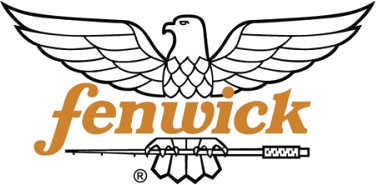
Fenwick – Lifetime warranty (except for HMG and Eagle models which only carry 5 year warranties). $35 handling fee. Broken sections are replaced. Sometimes the whole rod is replaced. If current rod sections are no longer available the rod will be replaced with a comparable model. If Fenwick determines that there was a defect, the rod will be repaired or replaced at no charge. Usually takes 2-4 weeks.
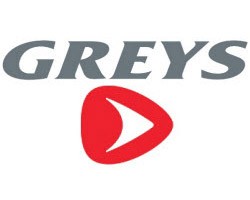
Greys – Lifetime warranty (except for HMG and Eagle models which only carry 5 year warranties). $35 handling fee. Broken sections are replaced. Sometimes the whole rod is replaced. If current rod sections are no longer available the rod will be replaced with a comparable model. If Greys determines that there was a defect, the rod will be repaired or replaced at no charge. Usually takes 2-4 weeks.

Hardy – Lifetime warranty to original owner. $75 handling fee. Rods are repaired or sections replaced. Shipping is from their US warehouse, usually takes 2 weeks.

G. Loomis – Lifetime warranty to original owner. If you feel your rod has broken because of a defect, you pay to send the rod to their warranty department for examination. If the rod is broken because of a defect, or while fishing, replacement is free. No handling fee. If broken from neglect or any other cause, you must use the Expeditor service. You call in and they charge your credit card $125 but you get a brand new rod in 3-4 days. The Expeditor service for the NRX+ or NRX+ LP NRX PRO-1, and IMX-PRO rods is $125, while the fee for Asquith rods is $275.00. With your new rod they include a FedEx call tag so that it does not cost you anything to return your broken rod.
New this year, G. Loomis is offering an Xpeditor Tip Service. Whether your tip was broken, or if you would just like to buy an extra for a backup, G. Loomis will send you a tip in 3-4 business days for a fee, depending on the model. For the IMX, GLX, NRX, or NRX+ rods the fee is $60, for Asquith models the fee is $75.00.
Note that if your rod has been discontinued for more than 5 years G.Loomis will not be able to replace the tip.

Moonshine – All rods have a lifetime warranty to the original owner. The Vesper series is $55 per section.You are sent the part within 5 business days with free 2-Day shipping. No need to send in the entire rod. No fee will be required if the problem is due to any manufacturing defect. International warranty claims may require an additional shipping fee. Select your rod on the website and chose the correct weight and broken section from the drop-down menu and pay online.

Orvis – 25 year no fault warranty to original owner. $60 handling fee. Rod is repaired, or sections replaced. If Orvis determines that there was a defect, the rod will be repaired or replaced at no charge. For Helios 3 and the current Clearwater series rods, Orvis offers a new section replacement program with a 5-business day turnaround through Orvis.com. Other repairs usually take 4-6 weeks.

Sage – Lifetime warranty to original owner. $25 handling fee on current rods. $75 on recent rods within 10 years, $125 on classic older rods. Rods are repaired, not replaced except for broken sections. Usually takes 4-8 weeks.

Scott – Lifetime warranty to original owner, $50 handling fee. Rods are repaired, not replaced, except for broken sections. Usually takes 4 weeks.

St. Croix – 15 year warranty on Imperial fly rods and 5 year warranty on Mojo Trout fly rods. Any tip section on any multi piece rod that is within the warranty period can be replaced at no charge other than a $25 shipping fee. Tip sections for multi-piece rods that are outside of their warranty period have varying prices depending on the series. Rods under warranty, needing full replacement, are $50 total under the Excellerator Plan. Rods outside of warranty, needing full replacement, have varying costs depending on series. Replacement time varies based on availability.
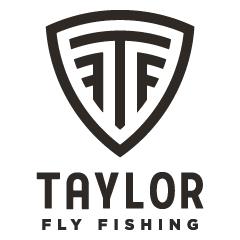
Taylor– Lifetime warranty to original owner. Warranty does not cover misuse, negligence, normal wear, fire, theft, loss, or intentional damage. $50 processing fee, not including shipping. Rods are repaired or replaced. Usually takes 1-2 weeks.
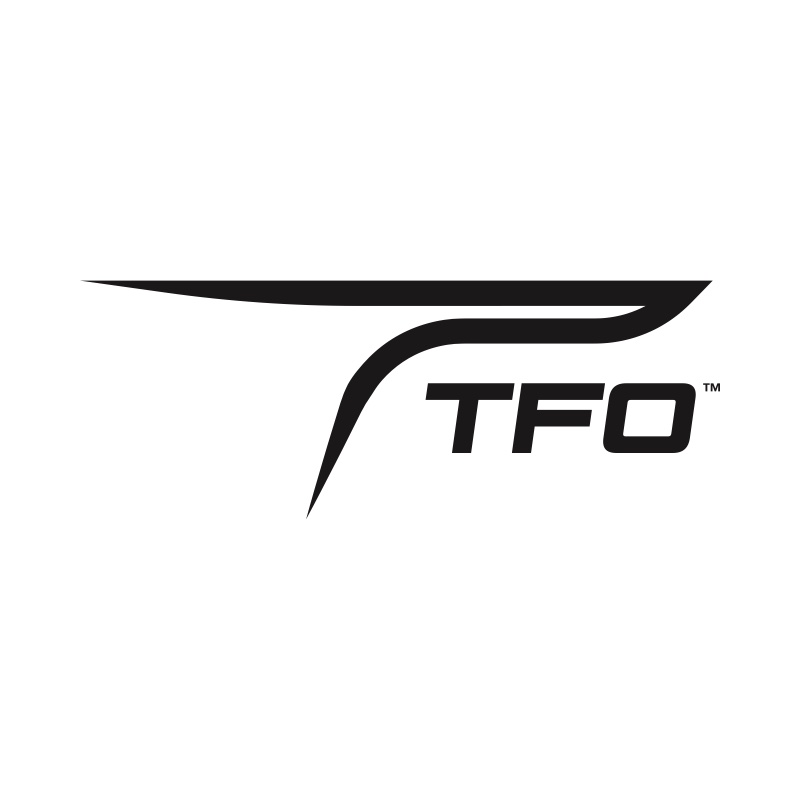
Temple Fork Outfitters (TFO)– Lifetime warranty to original owner. $35 handling fee. Rods are either replaced with a new rod or the broken section is replaced. Usually takes 1-2 weeks. For the fastest turnaround time, TFO also offers a “purchase parts” program which allows you to buy an extra tip, mid-section, or butt-section at a very reasonable fee, ranging from $20 and up depending on the model and section needed.

Thomas and Thomas – $65 repair charges for the original owner, includes shipping. For non-original owners the fee is $165 per section, with butt sections costing $225. For non-original owners on 2-pc models the fee is $275 per section (butt or tip). You must register the new rod within 30 days.
We hope you have enjoyed reading our 2021 6-Weight Shootout! These Shootouts take a lot of time and effort. With your support we can continue to give you more Shootouts and head to head comparisons on tackle and equipment in the future. So if you like what we are doing, and found this 6-Weight Shootout helpful, the best way to thank us is to buy a rod, reel, or outfit from the Yellowstone Angler.
OUR THOUGHTS ABOUT A PURCHASE, AGAIN
If you are thinking about buying a fly rod, we suggest reading one of our Shootouts for the line size rod you want. You’ll find these on our Yellowstone Angler home page at yellowstoneangler.com.
Call us at 406-222-7130, or e-mail us at staff@yellowstoneangler and we can discuss your needs and wants. I’m confident that we can come up with the perfect rod or outfit that best fits your needs.
If you are getting one of the Ultimate 6-weight outfits, we’ll throw in a SA Mastery MPX line for free (a $79.95 value). If you would prefer the Amplitude MPX, which are normally $129.95, we’ll upgrade you for an additional $50.00. We’ll also ship it to you for free, and since we are in Montana, there is no sales tax.
Once you get your new rod or outfit, do some casting on the lawn, and if you feel it is not just what you want, (and has not been fished), we’ll allow you to return it to us for a full refund, less the shipping charges.
Use this link to go to our Favorite Freshwater Outfits for the 3 through 8-weight rods, in our Online Store. Here you’ll find our recommendations in three price ranges: The Ultimate Outfit, Mid Priced Outfit and Best Buy Outfit.
If you are looking for that perfect saltwater outfit, then check out this link for our Favorite Saltwater Outfits.
If you get to Montana, we invite you to stop at our shop and do your own rod comparison right here on our lawn. We have several reels rigged with the various line sizes, and leaders, all ready to go. We’ll come out with you and give you some help to fine tune your casting stroke, or just help you with the basics. And once you’ve picked out the perfect rod, stay and enjoy a few days on the water with one of our top guides.
We value your comments about the Shootout and invite any questions you might have about it or your tackle needs. We have fished all over the world in both fresh and saltwater for a variety of fish, and we’ll be glad to answer all of your questions, to help you choose the perfect rod or outfit.

– George Anderson, James Anderson, and the Yellowstone Angler crew